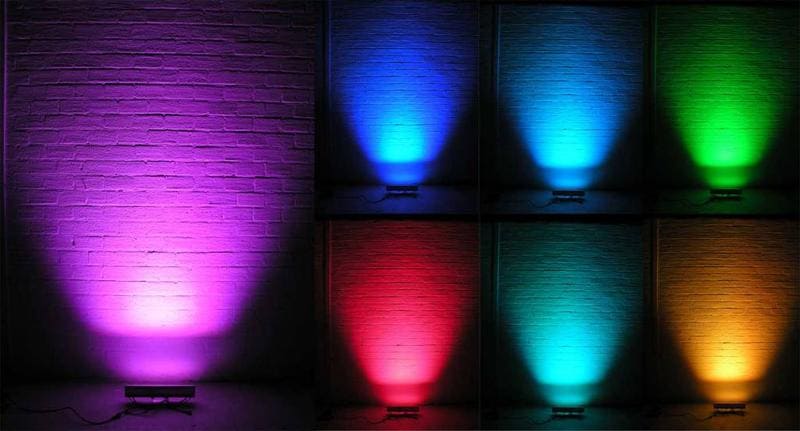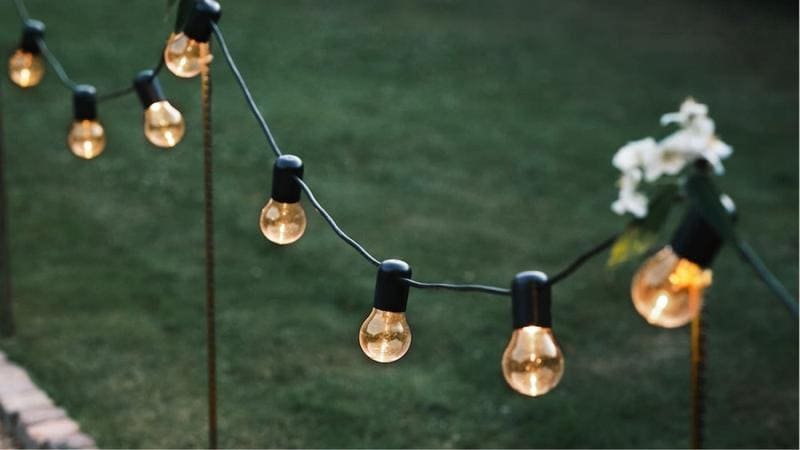أ. الدور المحوري للإضاءة في وضع مزاج ووظائف المنزل

تلعب الإضاءة دورًا مهمًا في خلق الأجواء المناسبة وتعزيز وظائف المساحات المختلفة في المنزل. إلى جانب الجماليات ، تؤثر الإضاءة بشكل كبير على مدى شعور الغرفة بالراحة والعملية. سواء كانت غرفة معيشة مريحة أو مطبخ مشرق أو مساحة عمل مركزة ، يمكن للإضاءة الصحيحة أن تحدث فرقًا كبيرًا في كيفية استخدام هذه المناطق. يمكن أن تؤكد الإضاءة على الميزات المعمارية ، وتحديد نغمة الأنشطة ، والتأثير على رفاهية أولئك الذين يسكنون المساحة. على سبيل المثال ، يمكن أن تساعد الإضاءة الدافئة في إنشاء بيئة مريحة ، في حين أن الإضاءة الأكثر برودة وأكثر إشراقًا يمكن أن تنشط مساحة للإنتاجية.
ب. تأثير درجة حرارة اللون على الغلاف الجوي وسهولة الاستخدام في غرف مختلفة
تعد درجة حرارة اللون عاملاً أساسياً في تصميم الإضاءة ، حيث إنها تؤثر بشكل مباشر على مزاج الغرفة وسهولة الاستخدام. تقاس في كلفن (K) ، تتراوح درجة حرارة اللون من الأشكال الدافئة والصفراء في تصنيفات كلفن السفلى (على سبيل المثال ، 3000K) إلى نغمات أكثر برودة ، مزرقًا في تقييمات أعلى (على سبيل المثال ، 6000K). غالبًا ما تستخدم الإضاءة الدافئة ، مثل 3000k ، في المناطق المخصصة للاسترخاء ، مثل غرف المعيشة وغرف النوم ، لأنها تخلق أجواء مريحة وحميمة. على النقيض من ذلك ، فإن الإضاءة الباردة ، مثل 4000k و 6000k ، أكثر ملاءمة للمساحات الموجهة نحو المهمة مثل المطابخ والحمامات والمكاتب المنزلية. توفر هذه النغمات الباردة الوضوح والسطوع اللازمة للأنشطة التي تتطلب التركيز والدقة.
نظرة عامة موجزة على خيارات إضاءة LED وتطبيقاتها
أصبحت إضاءة LED خيارًا شائعًا للمنازل الحديثة بسبب كفاءة الطاقة وطول العمر وتنوع درجات حرارة الألوان. تتوفر مصابيح LED في درجات حرارة ألوان مختلفة ، مما يجعلها مناسبة للتطبيقات المختلفة في جميع أنحاء المنزل. على سبيل المثال ، تعد مصابيح LED التي تبلغ تكلفتها 3000 كيلومتر مثالية لإنشاء بيئات دافئة وجذابة في مناطق مثل غرف المعيشة ومساحات الطعام. في هذه الأثناء ، توفر 4000 كيلو ليدت ضوءًا طبيعيًا محايدًا ، مثاليًا للمساحات مثل المطابخ والمكاتب المنزلية حيث يلزم توازن بين الدفء والسطوع. أخيرًا ، يتم استخدام مصابيح LED 6000K بشكل شائع في المناطق التي تتطلب رؤية ودقة عالية ، مثل ورش العمل والكراجات والإعدادات الخارجية.
شرح درجة حرارة لون الإضاءة
أ. تعريف درجة حرارة لون الإضاءة
تشير درجة حرارة لون الإضاءة إلى اللون المتصور أو لون الضوء المنبعث بمصدر إضاءة ، عادةً ما يتم قياسه في كلفين (ك). إنه يحدد ما إذا كان الضوء يبدو دافئًا أو محايدًا أو بارد ، مما يؤثر بشكل مباشر على المزاج والأجواء ووظائف المساحة. يعد مفهوم درجة حرارة اللون أمرًا ضروريًا في كل من تطبيقات الإضاءة السكنية والتجارية حيث يساعد في اختيار الإضاءة المناسبة لغرف ومهام محددة. يمكن أن تثير درجات حرارة الألوان المختلفة استجابات عاطفية متنوعة وتؤثر على قابلية استخدام المساحات. على سبيل المثال ، يمكن أن تخلق درجات الحرارة الأكثر دفئًا بيئة مهدئة ومريحة ، في حين أن درجات الحرارة الباردة أكثر تحفيزًا وغالبًا ما تستخدم في المناطق الموجهة نحو المهمة.
ب. مقياس كيلفن وقياسه للألوان الضوئية
يتم استخدام مقياس كيلفن لقياس درجة حرارة لون مصادر الضوء ، مما يوفر قيمة رقمية تتوافق مع ظلال مختلفة من الضوء. يبدأ المقياس حوالي 1000 كيلو ، وهو يمثل لونًا خافتًا اللون أحمر اللون ، ويمتد إلى ما يصل إلى 10000 ألف ، مما يشير إلى ضوء مشرق أزرق أبيض أقرب إلى ضوء النهار في فترة ما بعد الظهيرة الصافية. تنتج القيم المنخفضة على مقياس Kelvin (2700K-3000K) توهجًا دافئًا وصفرًا ، في حين أن القيم الأعلى (5000K-6500K) تؤدي إلى صبغ مزرق أكثر برودة. توفر القيم متوسطة المدى ، مثل 4000K ، توازنًا بين الدفء والبرودة ، مما يشبه وثيق ضوء النهار الطبيعي. يتيح فهم مقياس كيلفن أصحاب المنازل والمصممين اختيار الإضاءة التي تكمل الوظيفة والجو المطلوب للمساحة.
أمثلة على درجات حرارة الألوان وتأثيراتها على الأجواء
- 2700k: دافئ ودافئ مع توهج مصفر
يقع 2700k على الطرف السفلي من مقياس Kelvin ، مما يوفر ضوءًا ناعمًا ودافئًا يخلق جوًا مريحًا وجذابًا. في كثير من الأحيان مرتبطة بالمصابيح المتوهجة التقليدية ، تنبعث درجة حرارة اللون هذه توهجًا مصفرًا مثاليًا للمساحات التي يتم فيها إعطاء الأولوية للاسترخاء والراحة. على سبيل المثال ، يمكن أن تستفيد غرف المعيشة وغرف النوم ومناطق الطعام من التأثير الهادئ للإضاءة 2700k. يساعد هذا الدفء في وضع مزاج هادئ وحميمي ، مما يجعله مثاليًا للمساحات المخصصة للاسترخاء أو الترفيه عن الضيوف في بيئة مسترخي. بالإضافة إلى ذلك ، يمكن استخدام إضاءة 2700 ألف لإضاءة لهجة لتسليط الضوء على التفاصيل الفنية أو المعمارية ، مما يضيف العمق والدفء إلى تصميم الغرفة.
- 4000K: متوازن مثل ضوء النهار الطبيعي
عند 4000K ، تأخذ الإضاءة نغمة أكثر حيادية ، مما يوفر توازنًا بين الدفء والبرودة. غالبًا ما يتم وصف إضاءة 4000K أبيض محايد أو أبيض بارد ، وهي قابلة للمقارنة مع سطوع ووضوح ضوء النهار الطبيعي. هذا يجعلها خيارًا مثاليًا لمناطق المنزل التي تتطلب إضاءة موجهة نحو المهمة ، مثل المطابخ أو الحمامات أو المكاتب المنزلية. يتيح سطوع الإضاءة 4000k لتركيز أفضل ووضوح ، مما يجعلها مفيدة في المساحات التي يكون الاهتمام بالتفاصيل ضرورية ، مثل الطهي أو العمل في مكتب. بالإضافة إلى ذلك ، تستخدم درجة حرارة اللون هذه على نطاق واسع في الإعدادات التجارية ، بما في ذلك متاجر البيع بالتجزئة ، حيث تكون الإضاءة الواضحة والنابضة بالحياة مطلوبة لتسليط الضوء على المنتجات وضمان مظهر احترافي. يمكن أن يستكمل التوازن الذي توفره 4000 ألف إضاءة التصميمات الداخلية الحديثة ، مما يخلق جوًا نظيفًا وهشًا دون أن يكون قاسيًا للغاية.
- 5000k وما فوق: بارد سريريًا مع صبغة مزرق
بمجرد أن تصل درجة حرارة اللون إلى 5000 ألف وما فوق ، يبدأ الضوء في تناول صبغة أكثر برودة أو مزرقًا غالبًا ما توصف بأنها "ضوء النهار" أو "أبيض بارد". يذكرنا هذا النوع من الإضاءة بأشعة الشمس الصافية في منتصف النهار ، مما يجعله فعالًا للغاية للمساحات التي تتطلب مستوى عالٍ من السطوع والرؤية. بفضل مظهره الناتج والسريري ، غالبًا ما تستخدم إضاءة 5000k في البيئات الصناعية أو التجارية مثل ورش العمل والكراجات والمستشفيات ، حيث يكون الوضوح والدقة أمرًا بالغ الأهمية. في التطبيقات السكنية ، عادةً ما تكون الإضاءة 5000k مخصصة للمساحات مثل الطوابق السفلية أو غرف المرافق أو المناطق الخارجية حيث تكون الرؤية أكثر أهمية من الأجواء. على الرغم من أن هذه الإضاءة يمكن أن تخلق بيئة معقمة ومركزة ، إلا أنها أقل استخدامًا في المناطق المخصصة للاسترخاء بسبب تأثيرها المحفز وأحيانًا على العيون. يمكن أن يؤدي اللون الأزرق من الإضاءة 5000k أيضًا إلى قمع إنتاج الميلاتونين ، مما يجعله أقل ملاءمة للمناطق مثل غرف النوم أو غرف المعيشة حيث يكون الاسترخاء هو الهدف الأساسي.
باختصار ، يمكن لفهم مقياس كيلفن وكيف يمكن أن تؤثر درجات حرارة الألوان المختلفة على أن يساعد أصحاب المنازل على اتخاذ قرارات مستنيرة عند اختيار الإضاءة لمساحاتهم. من التوهج الدافئ والمريح البالغ 2700 ألف إلى الضوء المشرق المركز من 5000 ألف وما فوق ، يعد اختيار درجة حرارة الإضاءة المناسبة أمرًا ضروريًا في خلق بيئة منزلية وظيفية وجذابة.
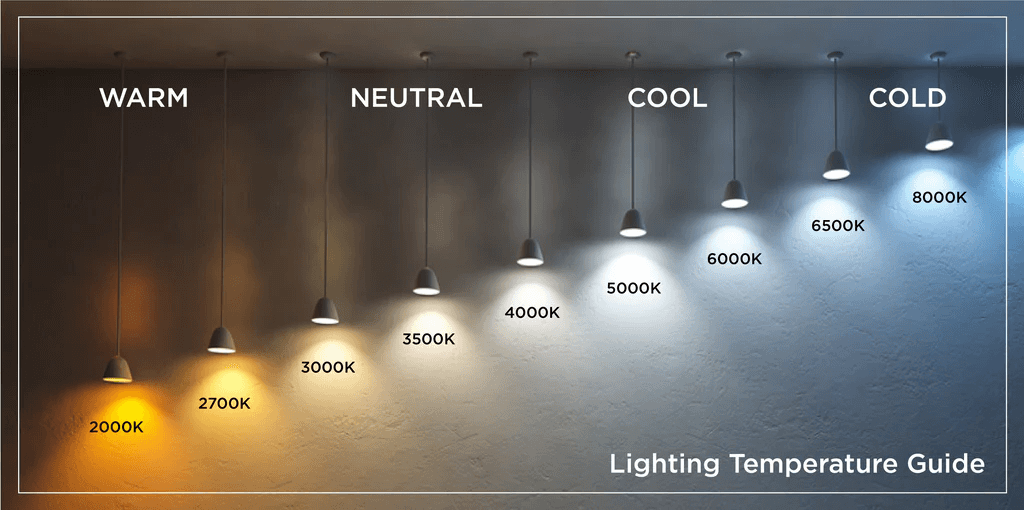
طيف درجات حرارة اللون
A. قائمة مفصلة لدرجات حرارة الألوان وخصائصها البصرية
يعد فهم درجات حرارة الألوان المختلفة وكيفية تأثيرها بصريًا على مساحة ضرورية لخلق الأجواء المناسبة في أي غرفة. تحدد درجة حرارة اللون ، التي تقاس في كلفن (K) ، لون النور الذي ينبعث منه المصباح ، بدءًا من نغمات دافئة وصفراء إلى ظلال باردة ومزرق. كل درجة حرارة لها خصائص مميزة وهي مناسبة لبيئات محددة.
- 2000k-2200k: أصفر-مثالي لخلق جو نائم
ينتمي نطاق 2000k-2200k إلى توهج ناعم أصفر ، يشبه وميض دافئ من المصابيح المتوهجة على ضوء الشموع أو القديمة. تعتبر هذه الإضاءة الفائقة الدافعة مثالية للمساحات المصممة للاسترخاء والانتهاء ، مثل غرف النوم أو الصالات. إن جوها النائم والمهدئ يعزز إنتاج الميلاتونين ، وهو الهرمون المسؤول عن تنظيم النوم ، مما يجعله مثاليًا للاستخدام في وقت متأخر من المساء. غالبًا ما تُرى هذه الإضاءة في المطاعم أو الحانات أو المساحات المنزلية الحميمة حيث يكون الهدف هو إثارة الدفء والراحة.
- 2700k-3000k: أبيض دافئ-مريح للإضاءة العامة
يستخدم نطاق 2700K-3000K ، يشار إليه عادة باسم الأبيض الدافئ ، على نطاق واسع في الإضاءة السكنية. تشبه درجة الحرارة هذه المصابيح المتوهجة التقليدية ، مما يوفر لونًا مريحًا وجذابًا أبيض مصفر. تعمل الإضاءة البيضاء الدافئة بشكل جيد في غرف المعيشة ومناطق تناول الطعام وغرف النوم ، حيث توفر بيئة مريحة ومريحة. إنه أيضًا خيار رائع لأغراض الإضاءة العامة ، لأنه يبدو طبيعيًا دون أن يكون قاسيًا جدًا أو خافتًا جدًا. إن التوهج الناعم المتمثل في الإضاءة 2700k-3000k يجعلها مثالية لخلق جو من الراحة والدفء ، مما يعزز الاسترخاء بينما لا يزال وظيفيًا.
- 3500k-4000k: أبيض محايد-مزيج من النغمات الدافئة والبرودة
نطاق 3500K-4000K ، الذي يُطلق عليه غالبًا أبيض محايد أو أبيض بارد ، عبارة عن مجموعة متوازنة من النغمات الدافئة والبرودة ، مما يوفر مظهرًا طبيعيًا ونظيفًا. تشبه هذه الإضاءة ضوء النهار ، مما يجعلها مناسبة للغرف التي تتطلب رؤية واضحة دون أن تتساقط الإضاءة الباردة. تستفيد المطابخ والحمامات والمكاتب المنزلية من نطاق درجة الحرارة هذا لأنه يعزز التركيز دون الشعور السريري للغاية. الإضاءة البيضاء المحايدة هي خيار متعدد الاستخدامات ، مما يمنح المساحات مظهرًا حديثًا جديدًا مع الحفاظ على درجة من الدفء. يتم استخدامه بشكل شائع في البيئات التجارية أيضًا ، حيث يكون الوضوح الطبيعي ضروريًا ولكن الجو البارد المفرط غير مطلوب.
- 5000k-6000k: أبيض بارد-تنشيط وجيد للتركيز
تنبعث الإضاءة في نطاق 5000k-6000k من الضوء الأبيض اللامع والبارد مع اللون المزرق الخفيف. تشتهر هذه درجة الحرارة بتأثيرها التنشيط ، وهي مثالية للمساحات التي يكون فيها التركيز والدقة مفتاحًا ، مثل المكاتب ومساحات العمل ومناطق الدراسة. يعزز الضوء الأبيض البارد اليقظة ويساعد على تقليل إجهاد العين أثناء المهام التي تتطلب الاهتمام بالتفاصيل. ومع ذلك ، بسبب شدتها ، يمكن أن تشعر بقسوة كبيرة للاسترخاء مثل غرف النوم أو غرف المعيشة. يستخدم العديد من الأشخاص هذا النطاق لإضاءة المهام بدلاً من الإضاءة المحيطة ، حيث يوفر الوضوح اللازم للعمل دون إنشاء بيئة مريحة وميدية.
- 6500k-8000k: أبيض بارد (ضوء النهار)-أقصى وضوح للمهام
في أعلى نهاية الطيف ، تنبعث إضاءة من 6500 كيلو إلى 8000 ألف من ضوء أبيض مزرق يُعرف باسم ضوء النهار أو الأبيض البارد. غالبًا ما تتم مقارنة درجة الحرارة هذه مع ضوء النهار الطبيعي عند الظهر وهي مثالية للمناطق التي تتطلب أقصى سطوع ووضوح. تستفيد المساحات مثل المرائب وورش العمل والمختبرات والإعدادات الخارجية من هذه الإضاءة بسبب قدرتها على تعزيز الرؤية والاهتمام بالتفاصيل. في الاستخدام السكني ، عادةً ما يتم حجز إضاءة 6500K-8000K للبيئات الخاصة بالمهمة ، حيث يمكن أن تشعر أنها معقمة للغاية بالنسبة لمعظم الإعدادات المنزلية. على الرغم من أن هذا الضوء ممتاز للإنتاجية ، فقد يتسبب هذا في عدم الراحة إذا تم استخدامه في المساحات المخصصة للاسترخاء.
ب. كيف يمكن أن تعزز درجات حرارة الألوان المختلفة أو تنتقص من جو الغرفة
تلعب درجة حرارة اللون دورًا حاسمًا في وضع مزاج ووظائف الغرفة. يمكن أن يؤدي اختيار درجة حرارة اللون المناسبة إلى تعزيز جو المساحة ، مما يجعله أكثر ترحيباً أو وظيفية أو تنشيطًا ، اعتمادًا على استخدامه المقصود. على العكس من ذلك ، يمكن أن ينتقص اختيار درجة حرارة اللون الخاطئة من المزاج المطلوب ويؤثر سلبًا على قابلية استخدام الغرفة.
على سبيل المثال ، في غرف المعيشة وغرف النوم ، تخلق درجات الحرارة الأكثر دفئًا (2000K-3000K) بيئة مريحة وحميمة تعزز الاسترخاء والاسترخاء. يمكن أن يكون استخدام الإضاءة الباردة المفرطة في هذه المساحات يشعر بالدهشة وغير المذهلة ، مما يؤدي إلى تعطيل راحة الغرفة. من ناحية أخرى ، فإن درجات الحرارة الأكثر برودة (5000K-6000K) مفيدة في المطابخ والحمامات والمكاتب ، حيث هناك حاجة إلى ضوء مشرق ، واضح لرؤية التفاصيل بوضوح والاستمرار في التركيز. ومع ذلك ، إذا كانت الإضاءة دافئة جدًا في هذه المناطق ، فقد تجعل المساحة تشعر باهظة ويقلل من الإنتاجية.
يعد الموازنة بين درجة حرارة اللون مع وظيفة الغرفة ضرورية لتحسين الراحة والكفاءة. تساعد الأضواء الدافئة في المساحات المخصصة للاسترخاء ، في حين أن الأضواء الباردة أكثر ملاءمة لمجالات النشاط والتركيز والدقة. إن فهم هذه الآثار يسمح باختيارات الإضاءة المتعمدة والفعالة.
أهمية درجة حرارة الإضاءة
أ. الآثار النفسية للإضاءة على الحالة المزاجية والسلوك
درجة حرارة الإضاءة لها تأثير عميق على علم النفس البشري ، والتأثير على المشاعر ، والسلوك ، وحتى الإنتاجية. تبين أن الإضاءة الأكثر دفئًا (عادة ما تكون حوالي 2700 كيلو و 3000 كيلو) تعزز الاسترخاء والراحة ، مما يخلق شعورًا بالعلاقة الحميمة والهدوء. هذا هو السبب في غالبًا ما يتم استخدامه في المساحات التي يتم فيها تشجيع الانتهاء أو التواصل الاجتماعي ، مثل غرف المعيشة وغرف النوم ومناطق الطعام. تحفز الأشكال الصفراء الناعمة المرتبطة بالإضاءة الدافئة إنتاج الميلاتونين ، وهو هرمون يساعد على تنظيم دورات النوم. نتيجة لذلك ، يمكن أن تساعد ظروف الإضاءة هذه الجسم على الاستعداد للراحة وتقليل مستويات التوتر.
على النقيض من ذلك ، فإن الإضاءة الباردة (4000K-6000K) ، مع نغماتها الأكثر إشراقًا والمشرقة ، تحفز وتنشيط. يمكن أن يزيد من اليقظة والتركيز ، مما يجعله مثاليًا للبيئات التي تكون فيها الإنتاجية مفتاحًا. غالبًا ما تستفيد المكاتب والمطابخ ومساحات العمل من الإضاءة الباردة ، لأنها تشجع على التركيز وزيادة الوضوح العقلي. ومع ذلك ، فإن التعرض المفرط للإضاءة الباردة للغاية ، وخاصة في المساء ، يمكن أن يقمع إنتاج الميلاتونين ، مما قد يؤدي إلى صعوبة في النوم وزيادة التوتر. لذلك ، يعد اختيار درجات حرارة الإضاءة المناسبة أمرًا ضروريًا للحفاظ على توازن صحي في الحالة المزاجية والسلوك ، اعتمادًا على الغرض من المساحة.
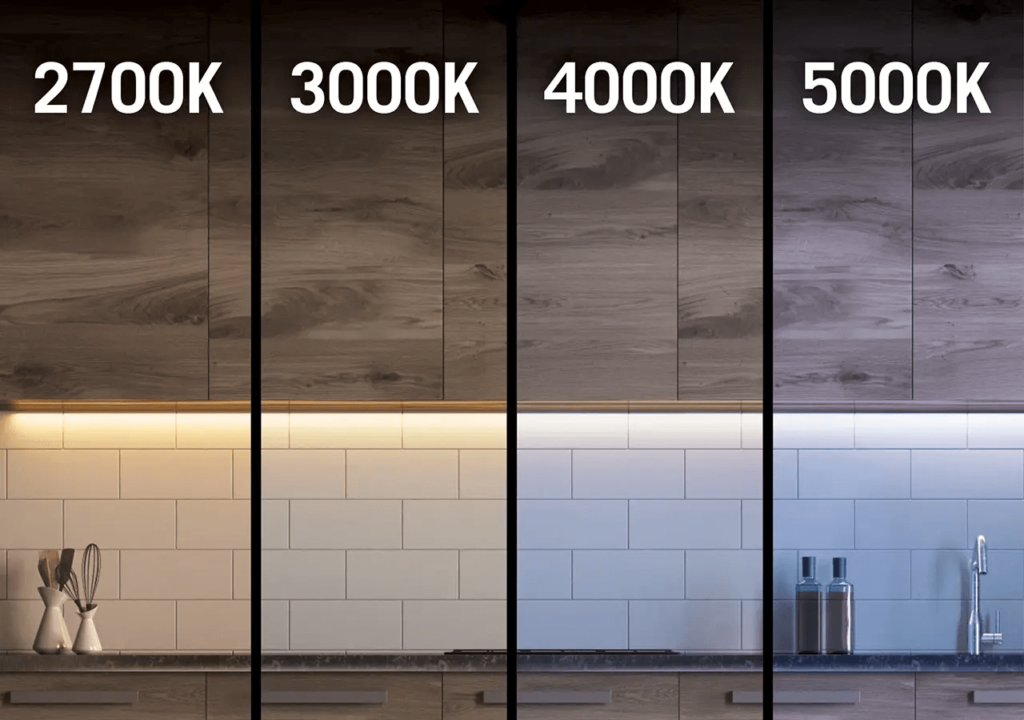
ب. اعتبارات عملية لغرف وأنشطة مختلفة
يجب أن يتوافق اختيار درجة حرارة الإضاءة مع الوظائف المحددة للغرفة والأنشطة التي يتم تنفيذها هناك. على سبيل المثال، تعتبر الإضاءة الدافئة (2700K-3000K) مثالية للمساحات المخصصة للاسترخاء، مثل غرف النوم وغرف المعيشة وغرف الطعام. يساعد التوهج المريح على خلق جو جذاب ومريح، مما يجعله مثاليًا للاسترخاء بعد يوم طويل.
تعمل الإضاءة المحايدة (3500K-4000K) على تحقيق التوازن بين الدفء والسطوع، مما يجعلها مناسبة لمناطق مثل المطابخ والحمامات والمكاتب المنزلية. تتطلب هذه المساحات إضاءة كافية للرؤية وإكمال المهمة، ولكن النبرة ليست قاسية جدًا. توفر الإضاءة المحايدة الوضوح دون شدة الإضاءة الباردة، مما يجعلها متعددة الاستخدامات للغرف التي تخدم وظائف متعددة.
غالبًا ما يتم تخصيص الإضاءة الباردة (5000K-6000K) للمساحات التي تتطلب رؤية وتركيزًا عاليين، مثل مساحات العمل والجراجات والمناطق الخارجية. كما يتم استخدامه في البيئات التي تكون فيها الدقة والاهتمام بالتفاصيل أمرًا بالغ الأهمية، مثل المختبرات أو الاستوديوهات الفنية. في حين أن الإضاءة الباردة يمكن أن تكون قاسية إذا تم الإفراط في استخدامها، إلا أنها ضرورية للمهام التي تتطلب التركيز والدقة.
ج. مفهوم طبقات الإضاءة للأجواء المتنوعة
تعد الإضاءة المتعددة الطبقات استراتيجية حاسمة لتحقيق التنوع والعمق في أجواء الغرفة. يتضمن هذا المفهوم الجمع بين أنواع الإضاءة المختلفة - الإضاءة المحيطة وإضاءة المهام والإضاءة المميزة - لإنشاء تصميم إضاءة متوازن وعملي يتكيف مع الاحتياجات والحالات المزاجية المختلفة.
تعمل الإضاءة المحيطة كمصدر الإضاءة الأساسي للغرفة، وعادةً ما يتم توفيرها عن طريق التركيبات العلوية. يجب اختيار درجة حرارة اللون بناءً على الغرض العام للغرفة؛ على سبيل المثال، إضاءة أكثر دفئًا لغرفة المعيشة أو إضاءة أكثر برودة لمساحة العمل. توفر إضاءة المهام، مثل الأضواء الموجودة أسفل الخزانة في المطبخ أو مصابيح القراءة في الدراسة، إضاءة مركزة لأنشطة محددة. غالبًا ما تستفيد هذه الطبقة من الإضاءة الباردة، لأنها تعزز الرؤية وتقلل من إجهاد العين. تضيف الإضاءة المميزة، مثل الأضواء الكاشفة أو المصابيح المزخرفة، الدفء والعمق والاهتمام البصري إلى الغرفة. عادةً ما تكون الإضاءة المميزة أكثر نعومة ودفئًا، مما يسلط الضوء على الميزات المعمارية أو القطع الفنية دون إرباك المساحة.
من خلال وضع هذه أنواع الإضاءة المختلفة ودرجات الحرارة ، يمكن لأصحاب المنازل إنشاء بيئات مرنة تلبي وظائف ومزاج مختلف. على سبيل المثال ، يمكن للأضواء القابلة للتجزئة أو التركيبات القابلة للتعديل أن تنتقل مساحة من الإضاءة المشرقة والموجهة نحو المهمة إلى إعداد أكثر استرخاء وحميمية ، مما يوفر مجموعة واسعة من خيارات الأجواء طوال اليوم. هذه القدرة على التكيف تجعل درجة حرارة الإضاءة والطبقة الأساسية في التصميم الداخلي الحديث.
اختيار الإضاءة المناسبة لمنزلك
تلعب الإضاءة دورًا مهمًا في تشكيل أجواء ووظائف وكفاءة الطاقة في منزلك. من خلال اختيار درجة حرارة الإضاءة المناسبة ، يمكنك إنشاء جو يناسب احتياجات كل غرفة محددة. إليك نظرة متعمقة على العوامل التي تؤثر على خيارات الإضاءة وبعض الاستراتيجيات لتجربة درجات حرارة ألوان مختلفة.
أ. العوامل التي تؤثر على اختيار درجة حرارة الإضاءة
1. الغرفة الغرض العامل الأساسي في اختيار درجة حرارة الإضاءة اليمنى هو الغرض من الغرفة. تخدم كل مساحة في منزلك وظيفة مختلفة ، ويجب أن تكمل الإضاءة هذه الوظائف:
- غرف المعيشة وغرف النوم غالبًا ما يستفيد من الإضاءة الأكثر دفئًا (حوالي 3000 ألف) ، مما يخلق جوًا مريحًا ومريحًا يفضي إلى الاسترخاء بعد يوم طويل.
- المطابخ والمكاتب المنزلية تتطلب إضاءة أكثر إشراقًا وأكثر برودة (4000 ألف) للوضوح والتركيز ، مما يسهل العمل أو إعداد وجبات بدقة.
- الحمامات غالبًا ما تحتاج إلى مزيج من الإضاءة. على سبيل المثال ، تساعد الإضاءة الباردة بالقرب من المرايا في الاستمالة ، في حين أن الإضاءة الأكثر ليونة في مكان آخر تحافظ على أجواء مريحة.
- المرائب والطوابق السفلية قد تتطلب إضاءة ألمع وأروع ، مثل 6000k ، لضمان الرؤية خلال المهام التفصيلية مثل إصلاحات السيارات أو الحرف اليدوية.
إن مطابقة درجة حرارة الإضاءة مع الغرض المحدد للغرفة يضمن الراحة والكفاءة في المهام اليومية.
2. الأجواء المطلوبة تؤثر درجة حرارة الإضاءة بشكل كبير على أجواء الغرفة. تخلق درجة حرارة اللون الدافئة (3000k أو أقل) مزاجًا جذابًا وحميميًا ، ومثاليًا للمساحات مثل غرف المعيشة أو غرف النوم أو مناطق تناول الطعام حيث يتم إعطاء الأولوية للراحة. على العكس من ذلك ، توفر درجات حرارة الألوان الباردة (4000 ألف وأعلى) جوًا أكثر نظافة وأكثر حيوية تعمل بشكل جيد في المناطق التي تكون فيها الإنتاجية مفتاحًا ، مثل المكاتب المنزلية أو المطابخ. يؤثر اختيار لون الإضاءة بشكل مباشر على شعور الغرفة - والاسترخاء أو المشرق والتنشيط.
3. كفاءة الطاقة كفاءة الطاقة هي اعتبار أساسي آخر عند اختيار الإضاءة. تعد مصابيح LED خيارًا أفضل لتوفير الطاقة لأنها تستخدم قوة أقل بكثير من المصابيح المتوهجة التقليدية. عند اختيار درجات حرارة الإضاءة ، ضع في اعتبارك أن خيارات الإضاءة الباردة تميل إلى أن تكون أكثر كفاءة في الطاقة أكثر من تلك الأكثر دفئًا بسبب تكوينها. ومع ذلك ، فإن الفرق هو الحد الأدنى ، وغالبًا ما يفوق التفضيل الشخصي ميزة الطاقة الطفيفة هذه. توفر مصابيح LED ، بشكل عام ، توازنًا بين الحفاظ على الطاقة وتوفير التكاليف على المدى الطويل ، لأنها تتمتع بعمر أطول من الأنواع الأخرى من المصابيح.
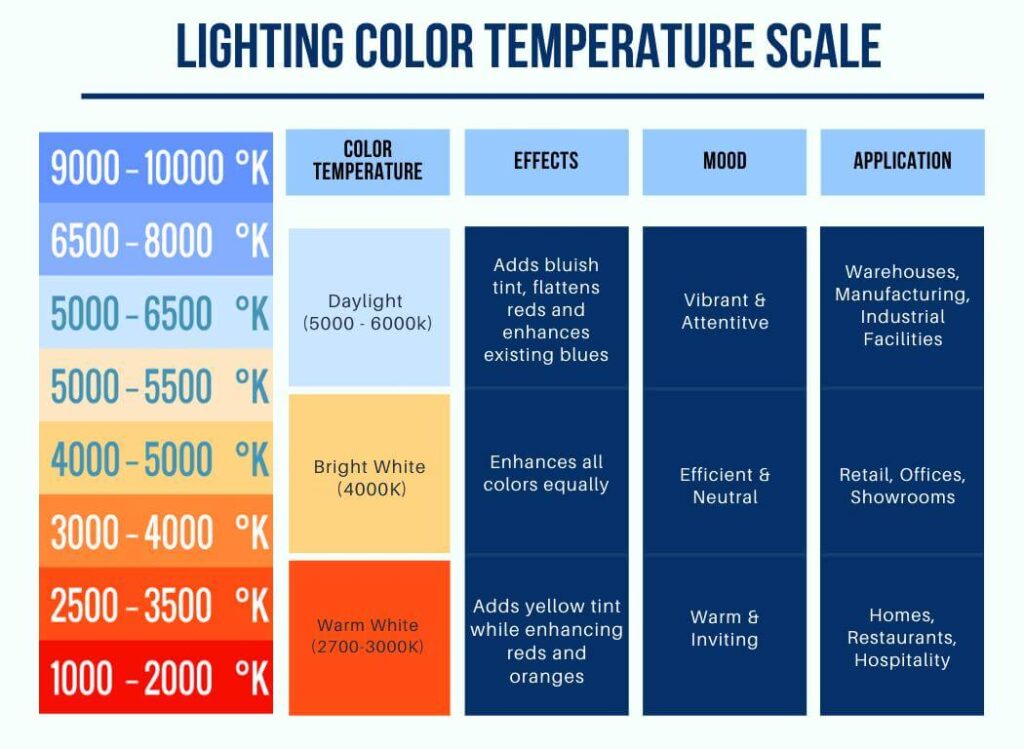
ب. دور التفضيل الشخصي في اختيار الإضاءة
في حين أن الوظيفة والأجواء أمران حاسمان ، فإن التفضيلات الشخصية تلعب دورًا كبيرًا في خيارات الإضاءة. كل شخص لديه حساسيات مختلفة للضوء. على سبيل المثال ، قد يجد بعض الأشخاص إضاءة أكثر برودة (من 4000 كيلو إلى 6000 ألف) قاسية للغاية بالنسبة للمساحات السكنية ، مفضلين الدفء الناعم للإضاءة البالغة 3000 ألف ، حتى في غرف ثقيلة المهام مثل المطابخ أو المكاتب. وبالمثل ، قد يختار أولئك الذين يفضلون الحد الأدنى والجمالية الحديثة مظهرًا أنظف للإضاءة الباردة في مساحاتهم المعيشية ، على الرغم من الاقتراح التقليدي للنغمات الدافئة. يعد الذوق الشخصي والراحة والأسلوب العام لمنزلك مفتاح اللمسات الأخيرة على قرارات الإضاءة الخاصة بك.
جيم استراتيجيات لتجربة درجات حرارة ألوان مختلفة
عند تحديد أفضل درجة حرارة الإضاءة لمنزلك ، من الضروري تجربة خيارات مختلفة. فيما يلي بعض الاستراتيجيات للعثور على ما هو أفضل:
- استخدم مصابيح LED قابلة: تتيح لك الأضواء القابلة للتجزئة تغيير شدة الإضاءة لتناسب مزاج ومهام مختلفة. كما أنها توفر وسيلة للتحول بين النغمات الباردة والدفء إذا قمت بتحديد مصابيح LED قابلة للضبط ، مما يوفر مرونة أكبر في تركيبات واحدة.
- جرب مصابيح LED القابلة للتعديل أو القابلة للضبط: تتيح لك بعض تركيبات LED الحديثة ضبط درجة حرارة اللون نفسها ، والتبديل بين نغمات أكثر دفئًا أو محايدة أو أكثر برودة. هذا مثالي للمساحات التي تخدم أغراض متعددة ، مثل المكتب المنزلي الذي يعمل أيضًا كمنطقة استرخاء في المساء.
- اختبار الإضاءة في غرف مختلفة: نظرًا لأن الإضاءة تؤثر على الحالة المزاجية والوظائف ، فحاول وضع المصابيح بدرجات حرارة ألوان مختلفة في غرف مختلفة. على سبيل المثال ، ابدأ بالإضاءة الدافئة في غرفة المعيشة والإضاءة الباردة في الحمام أو المطبخ. بمرور الوقت ، لاحظ كيف تؤثر درجات الحرارة هذه على راحتك وإنتاجيتك في كل مساحة.
- النظر في وضع وضع الإضاءة الخاصة بك: تتيح لك الإضاءة ذات الطبقات ، والتي تتضمن إضاءة المحيطة والمهمة واللكنة ، مزج درجات حرارة ألوان مختلفة لإنشاء مساحة أكثر ديناميكية وتنوعا. على سبيل المثال ، قد تستخدم الإضاءة الدافئة للضوء المحيط ولكن إضاءة المهام الأكثر برودة في مناطق العمل ، مما يمنحك أفضل ما في العالمين.
درجة حرارة لون الإضاءة 3000K
أ. خصائص الإضاءة 3000k: دافئة ، دعوة ، والاسترخاء
تشتهر الإضاءة بدرجة حرارة اللون 3000 كيلو بخصائصها الدافئة والدعوة والاسترخاء. إنه ينبعث من لون ناعم ، مصفر أبيض يحاكي دفء المصابيح المتوهجة التقليدية. تقع درجة الحرارة هذه على الجانب الأكثر دفئًا من مقياس كيلفن ، مما يخلق أجواءًا تشعر بالاسترداد والهدوء. يعد التوهج الدقيق الذي يبلغ 3000 ألف إضاءة مثاليًا لتعزيز الشعور بالراحة ، مما يجعله خيارًا ممتازًا للمساحات المصممة للاسترخاء والتواصل الاجتماعي. تكون درجة حرارة الإضاءة هذه فعالة بشكل خاص في تليين مظهر الغرفة ، مما يمنحها جوًا ترحيبيًا وحميمًا يشجع الناس على الاسترخاء والشعور بالراحة.
على عكس الإضاءة الباردة ، والتي يمكن أن تشعر بعقار أو مشرق للغاية ، تضيف الإضاءة التي يبلغ طولها 3000 كيلو الدفء إلى مساحة دون أن يطغى عليها. إنه يلفت التوازن بين السطوع والنعومة ، مما يوفر إضاءة كافية للأنشطة اليومية مع الحفاظ على شعور مهدئ. هذه الجودة تجعلها واحدة من أكثر الخيارات شعبية للإضاءة السكنية ، حيث أنها تعزز الدفء الطبيعي للمواد مثل الخشب والنسيج وغيرها من القوام العضوية ، مما يساعد على خلق بيئة متناغمة وسلمية.
ب. المزايا: مثالية للتواصل الاجتماعي والانهيار
واحدة من المزايا الأساسية للإضاءة 3000k هي قدرتها على تعزيز بيئة مريحة ومرعة. توهجه الدافئ الناعم مثالي للمناطق التي يجتمع فيها الناس ، مثل غرف المعيشة وغرف الطعام وغرف النوم. في هذه المساحات ، تشجع جودة الإضاءة الجذابة البالغة 3000 ألف على الاسترخاء والراحة ، مما يسهل الاسترخاء بعد يوم طويل أو الاستمتاع بمحادثات ذات مغزى مع العائلة والأصدقاء.
بالإضافة إلى ذلك ، من المعروف أن النغمات الدافئة للإضاءة 3000k لها تأثير مهدئ على الجسم والعقل. تساعد درجة حرارة الإضاءة هذه على تقليل التوتر ويمكن أن تعزز إنتاج الميلاتونين ، وهو هرمون ينظم دورات النوم. نتيجة لذلك ، غالبًا ما يتم استخدامه في غرف النوم أو المناطق التي يكون فيها الانتهاء أمرًا مهمًا ، مثل القراءة الزوايا أو مساحات المعيشة. يخلق الضوء الناعم جوًا حميمًا يشجع الشعور بالسلام ، مما يجعله مثاليًا للاسترخاء في المساء أو التجمعات الاجتماعية.
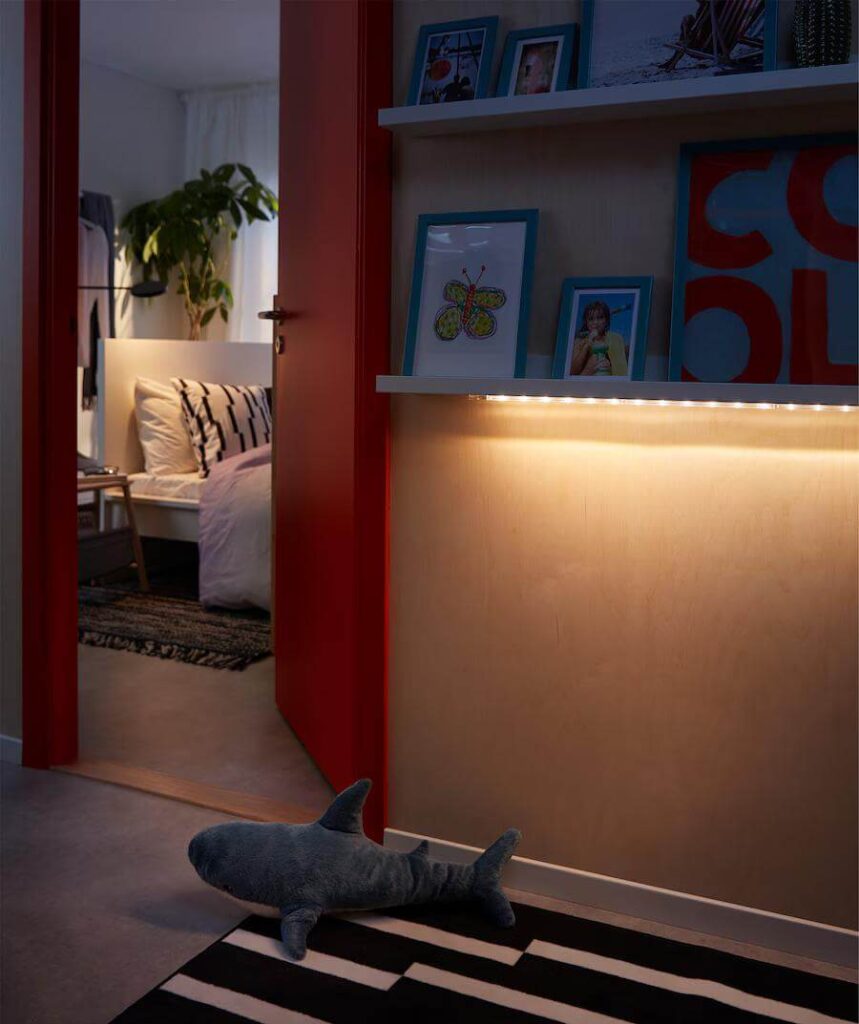
ج. العيوب: قد تفتقر إلى السطوع للمهام التفصيلية
بينما تتفوق الإضاءة التي تبلغ قيمتها 3000 ألف في خلق بيئة دافئة ومريحة ، إلا أنها قد لا توفر سطوعًا كافيًا للمهام التي تتطلب مستوى عالٍ من التفاصيل أو التركيز. على سبيل المثال ، في المساحات التي تكون فيها الدقة والوضوح ضرورية - مثل المطابخ أو المكاتب المنزلية أو الحمامات - قد تشعر الإضاءة 3000K باهظة أو مصفر للغاية ، مما يجعل من الصعب رؤيتها بوضوح. وينطبق هذا بشكل خاص على المهام مثل الطهي أو العمل في مكتب أو تطبيق مكياج ، حيث غالبًا ما تفضل إضاءة أكثر إشراقًا وأكثر برودة لضمان الدقة وتقليل إجهاد العين.
يمكن أن تكون الطبيعة الناعمة والمريحة لإضاءة 3000k أقل فعالية في المساحات التي تحتاج إلى الشعور بالتنشيط أو الإنتاجية. على سبيل المثال ، في مكتب المنازل أو ورشة العمل ، حيث يكون التركيز والتركيز الأساسي ، قد لا يوفر الإضاءة الدافئة الحدة اللازمة للحفاظ على اليقظة. في هذه البيئات ، غالبًا ما تكون درجات حرارة الإضاءة الأكثر برودة (مثل 4000K أو 5000K) أكثر ملاءمة لأنها توفر ضوءًا أكثر إشراقًا وأكثر وضوحًا يعزز الرؤية ويساعد على تحسين التركيز.
المناطق المناسبة: غرف النوم وغرف المعيشة ومناطق الطعام وإضاءة لهجة
الإضاءة 3000k مناسبة بشكل خاص للمناطق في المنزل حيث يكون الاسترخاء والراحة والتفاعل الاجتماعي من الأولويات. تعد غرف النوم موقعًا مثاليًا للإضاءة 3000k ، حيث يساعد التوهج الدافئ على خلق بيئة هادئة ومهدئة مفضية للراحة والنوم. في غرف المعيشة ، توفر درجة حرارة الإضاءة هذه أجواء مريحة ، مما يجعل المساحة مثالية لتفكيك الضيوف أو الترفيهين. وبالمثل ، تستفيد غرف الطعام من الأجواء الجذابة والحميمة التي يخلقها إضاءة 3000k ، مما يضع مزاجًا مثاليًا للوجبات والمحادثات المشتركة.
بالإضافة إلى الإضاءة العامة ، يتم استخدام 3000K المصباح بشكل شائع للإضاءة لهجة. سواء كان تسليط الضوء على الأعمال الفنية ، أو الميزات المعمارية ، أو إنشاء توهج دافئ في الأخلاق ورفوف الكتب ، يضيف إضاءة 3000K عمقًا ودفءًا إلى مناطق محددة من الغرفة. هذا يجعله خيارًا متعدد الاستخدامات لإضافة الاهتمام البصري وتعزيز النداء الجمالي للمساحة دون التغلب على مخطط الإضاءة الرئيسي.
E. مقارنة بالمصابيح المتوهجة وغيرها من الإضاءة الدافئة
غالبًا ما تتم مقارنة الإضاءة 3000k بالمصابيح المتوهجة التقليدية ، حيث يتشترك كلاهما في اللون الدافئ الصفراء. المصابيح المتوهجة ، التي عادة ما تكون درجة حرارة لون تبلغ حوالي 2700 ألف ، معروفة بالضوء الناعم الدافئ الذي كان عنصرًا أساسيًا في الأسرة منذ عقود. في حين أن المصابيح المتوهجة توفر لهجة أكثر دفئًا وأكثر صفراءًا من مصابيح LED 3000K ، فإن خيارين الإضاءة ينتجان تأثيرًا مشابهًا من حيث إنشاء جو مريح وجذاب.
ومع ذلك ، فإن المصابيح 3000k LED لها العديد من المزايا على الإضاءة المتوهجة. LEDs أكثر كفاءة في الطاقة ، وتدوم أطول بكثير وتستهلك قوة أقل. هذا يجعلهم خيارًا أكثر استدامة وفعالية من حيث التكلفة لأصحاب المنازل الذين يرغبون في الحفاظ على جمالية الإضاءة الدافئة دون عيوب المصابيح المتوهجة التقليدية ، مثل عمرهم الأقصر واستهلاك الطاقة الأعلى. بالإضافة إلى ذلك ، تتيح تقنية LED لمزيد من المرونة من حيث التعتيم وتباين الألوان ، مما يمنح المستخدمين مزيدًا من التحكم في أجواء مساحتهم.
بالمقارنة مع خيارات الإضاءة الدافئة الأخرى ، توفر 3000 كيلو LED أرضًا وسطًا بين الأشكال الفائقة المدفوعة من 2700 ألف ونغمات أكثر برودة تبلغ 4000 ألف. هذا يجعل 3000K خيارًا متعدد الاستخدامات يوازن بين دفء الإضاءة التقليدية مع الوضوح اللازم لمساحات المعيشة الحديثة. على الرغم من أن الإضاءة 2700k قد تكون قاتمة للغاية بالنسبة لبعض المناطق و 4000K مشرقة جدًا أو سريرية ، فإن 3000K تقدم حل وسط مثالي لخلق بيئة ترحيبية ومريحة في مجموعة متنوعة من الإعدادات.
درجة حرارة لون الإضاءة 4000K
أ. خصائص الإضاءة 4000k: نظيفة ومشرقة وحديثة
إضاءة 4000k ، التي يشار إليها غالبًا باسم بيضاء أو بيضاء محايدة ، تشتهر بإضاءةها النظيفة والمشرقة. الوقوع بين النغمات الصفراء الأكثر دفئًا من 3000 ألف والألوان الزرقاء الباردة التي تبلغ 5000 ألف ، و 4000 ألف تنبعث من ضوء متوازن يجمع بين أفضل ما في العالمين. إنه ليس دافئًا جدًا ولا بارد جدًا ، مما يوفر مظهرًا محايدًا يشبه إلى حد كبير ضوء النهار الطبيعي. توفر درجة الحرارة هذه مظهرًا واضحًا وحديثًا يعزز الرؤية ويوفر وضوحًا ممتازًا ، مما يجعلها مناسبة للغاية للمساحات التي تكون فيها المهام التي تتطلب الدقة والتركيز شائعة.
بصريًا ، تنتج إضاءة 4000K ضوءًا أبيضًا واضحًا يضيء المساحات دون إنشاء صبغة مصفر مرتبطة بالأضواء الأكثر دفئًا أو النغمة الأزرق الصارخ من الأضواء الباردة. تكمل لوحة الألوان المحايدة أنماط التصميم التقليدية والمعاصرة ، مما يجعلها خيارًا متعدد الاستخدامات لمجموعة واسعة من البيئات. بسبب سطوعها ووضوحها ، فإن الإضاءة 4000k تعزز الجمالية الشاملة للمساحة ، مما يجعلها تشعر بالانفتاح والهوية والطازجة. هذه الجودة الحديثة والنظيفة تجعلها مثالية للبيئات التي تتطلب مستوى عالٍ من الدقة البصرية أو حيث يكون المظهر الأنيق والأحد الحد الأدنى مطلوبًا.
B. المزايا: ممتازة للمهام التي تتطلب الاهتمام بالتفاصيل
واحدة من المزايا الأساسية للإضاءة 4000k هي مدى ملاءمة المهام التي تتطلب الدقة والاهتمام بالتفاصيل. تكون درجة حرارة اللون هذه مشرقة بدرجة كافية لإلقاء الضوء على المساحات بشكل فعال ، مما يضمن أن التفاصيل الصغيرة واضحة بشكل واضح ، سواء كنت تطبخ أو تعمل في مكتب أو تنهي في الحمام. يقلل الضوء المشرق والمحايد البالغ 4000 ألف من إجهاد العين ويحسن التركيز ، مما يجعله خيارًا ممتازًا للمناطق التي يكون الوضوح فيها أمرًا بالغ الأهمية.
على سبيل المثال ، في المطابخ ، حيث يكون تسليم الألوان الدقيق مهمًا لإعداد الطعام ، يضمن الضوء الوشم الذي توفره 4000 ألف لمبة أن المكونات سهلة رؤيتها والعمل معها. وبالمثل ، في المكاتب المنزلية ، تعد درجة الحرارة هذه مثالية للقراءة والكتابة والعمل على جهاز كمبيوتر ، حيث إنها تعزز الرؤية دون التسبب في الوهج القاسي المرتبط بالأضواء الباردة. بالإضافة إلى ذلك ، تستفيد الحمامات من إضاءة 4000k ، حيث مهام مثل حلاقة أو تطبيق إضاءة دقيقة للمكياج لتجنب الظلال أو التشوهات.
4000K الإضاءة هي أيضا متعددة الاستخدامات للغاية. إنه يعمل بشكل جيد في الإعدادات التجارية ، مثل المكاتب ومتاجر البيع بالتجزئة والمستشفيات ، حيث يكون التركيز والإنتاجية أمرًا بالغ الأهمية. يساعد الضوء المشرق والنظيف للأشخاص على البقاء في حالة تأهب وتركيز ، مما يجعله خيارًا عمليًا لمساحات العمل والمناطق التي تكون فيها الكفاءة مهمة.
ج. العيوب: قد تشعر سريريًا جدًا أو قاسيًا في بعض الإعدادات
على الرغم من العديد من مزاياها ، قد تشعر الإضاءة 4000K السريرية أو القاسية في إعدادات معينة. نظرًا لجودتها المشرقة والمحايدة ، يمكن أن تخلق درجة الحرارة هذه في بعض الأحيان جوًا معقمًا أو غير شخصي بشكل مفرط ، والذي قد لا يكون مناسبًا للمساحات المخصصة للاسترخاء أو الترفيه. في غرف مثل غرف المعيشة أو غرف النوم ، حيث يكون الأجواء المريحة والدعوة مرغوبة ، يمكن أن تشعر الإضاءة 4000k الباردة وغير المرغوب فيها.
يمكن أن تفتقر حياد الإضاءة 4000k أيضًا إلى الدفء والحميمية التي تستفيد منها بعض البيئات. على سبيل المثال ، في مناطق تناول الطعام أو غرف العائلة ، قد تشعر هذه الإضاءة بقسوة كبيرة ، مما يجعلها أقل مواتية لخلق جو مريح أو حميم. بالإضافة إلى ذلك ، يمكن أن يؤدي التعرض المطول للإضاءة الباردة إلى إرهاق العين وعدم الراحة في المساحات المخصصة للاسترخاء ، مما يجعله أقل مثالية للمناطق التي يستريح فيها الناس بعد يوم طويل.
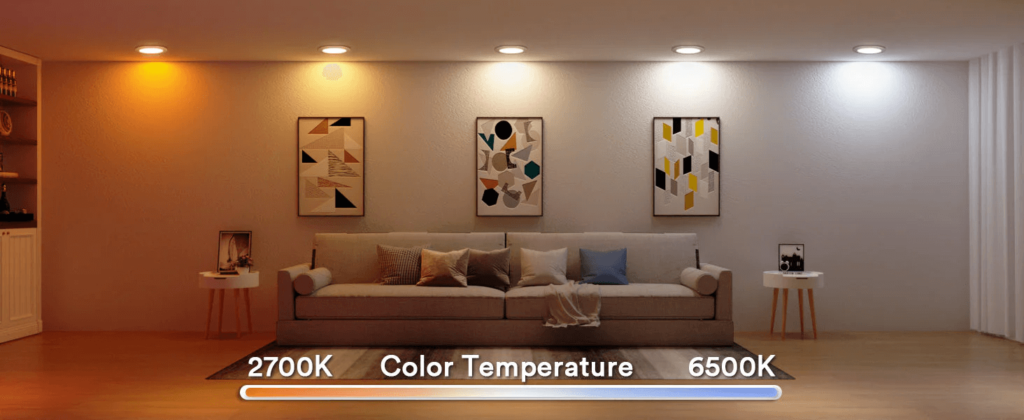
المناطق المناسبة: المطابخ والحمامات والمكاتب المنزلية والمداخل
الإضاءة 4000k مناسبة بشكل خاص للمساحات الوظيفية في المنزل حيث يكون الوضوح والسطوع ضروريين. مطابخ are an ideal environment for 4000K lighting, as this temperature offers the perfect blend of brightness and color accuracy for food preparation and cooking. The clean, white light enhances visibility, allowing for better safety and efficiency in this highly utilized area.
الحمامات also benefit from 4000K lighting, especially around mirrors where detailed grooming tasks, such as shaving or applying makeup, require optimal lighting conditions. The bright, neutral light reduces shadows and provides a clear reflection, ensuring that tasks are done with precision.
In home offices، 4000K الإضاءة تعزز الإنتاجية والتركيز. يساعد الضوء المشرق والبلد على تقليل إجهاد العين خلال فترات طويلة من القراءة أو الكتابة أو العمل على الكمبيوتر ، مما يجعله اختيارًا عمليًا لمساحات العمل. علاوة على ذلك، المداخل الاستفادة من المظهر النظيف والترحيب للإضاءة 4000k ، مع التأكد من أن هذه المساحات الانتقالية مضاءة جيدًا ودعوة دون الشعور بالدفء أو الخافت بشكل مفرط.
E. دور الإضاءة 4000k في التصميم الداخلي المعاصر
أصبحت الإضاءة 4000k عنصرًا أساسيًا في التصميم الداخلي المعاصر ، ويرجع ذلك إلى حد كبير إلى قدرتها على خلق جو مشرق وحديث. يكمل الضوء الأبيض المحايد الجماليات البسيطة والأنيقة التي تحدد التصميمات الداخلية الحديثة. في المساحات التي تهيمن عليها الخطوط النظيفة ، والألوان المحايدة ، والتخطيطات المفتوحة ، تعزز الإضاءة 4000K من حدة الميزات المعمارية وتضمن أن الغرف تشعر بالاسعة والمشرقة.
تتزوج درجة حرارة الإضاءة هذه بشكل جيد مع مواد معاصرة مثل الزجاج والمعادن والخرسانة ، والتي تستفيد جميعها من الوضوح والسطوع الذي توفره الإضاءة 4000k. إن قدرتها على تسليط الضوء على الملمس وتفاصيل هذه المواد تجعلها خيارًا ممتازًا للمطابخ ذات الأجهزة الفولاذية المقاوم للصدأ ، والحمامات الحديثة مع تركيبات الكروم ، ومساحات معيشة مع نوافذ كبيرة وعناصر طبيعية. يضمن اللون المحايد من 4000k إضاءة أيضًا أنه لا يتداخل مع أو تشويه ألوان المفروشات والديكور ، مع الحفاظ على سلامة خيارات التصميم الداخلي.
بالإضافة إلى ذلك ، غالبًا ما تستخدم إضاءة 4000k مع درجات حرارة الإضاءة الأخرى لإنشاء مخططات إضاءة ذات طبقات في المنازل الحديثة. على سبيل المثال ، على الرغم من أن 4000K بمثابة ضوء مهمة ممتازة في المطابخ أو الحمامات ، إلا أنه يمكن استكماله بإضاءة أكثر دفئًا في مناطق المعيشة أو لتناول الطعام لإنشاء جو متوازن يتحول بين المزاج والوظائف المختلفة. إن التنوع والتوازن الذي توفره الإضاءة 4000k يجعلها مكونًا رئيسيًا في التصميم المعاصر ، حيث تلبي الوظيفة الجماليات.
في الختام ، تعد الإضاءة 4000k خيارًا ممتازًا للمساحات التي تتطلب إضاءة مشرقة ونظيفة وحديثة. على الرغم من أنها قد لا تكون مثالية لكل غرفة ، فإن قدرتها على توفير الوضوح وتعزيز التركيز تجعلها لا تقدر بثمن في المطابخ والحمامات والمكاتب والمساحات الأخرى الموجهة نحو المهمة. عندما تم دمجها بشكل مدروس في خطة التصميم ، تساهم الإضاءة 4000K بشكل كبير في الوظيفة والجاذبية الجمالية للمنازل المعاصرة والبيئات التجارية.
6000k درجة حرارة الإضاءة
أ. خصائص الإضاءة 6000k: مشرقة ، واضحة ، وضوء النهار تشبه
تتميز الإضاءة 6000k بسطقها الشديد ، ونغمات بيضاء هش ، وتشبه إلى ضوء النهار الطبيعي. عند السقوط في الطرف الأعلى من مقياس كيلفن ، ينبعث من ضوء بارد وبيضاء مزرق يحاكي شعور ضوء النهار خلال منتصف النهار ، مما يجعله مثاليًا للبيئات التي تكون فيها الإضاءة الواضحة والمركزة ضرورية. غالبًا ما يشار إلى هذا النوع من الإضاءة على أنه "أبيض بارد" أو "ضوء النهار" بسبب قدرته على تكرار وضوح وشدة ضوء الشمس. يضمن الضوء الساطع الصارخ الناتج عن مصابيح LED 6000K رؤية ممتازة ويحدد تصور التفاصيل ، مما يجعله مناسبًا للإعدادات التي تتطلب دقة ومستوى عالٍ من السطوع.
Visually, 6000K lighting can transform a space, making it feel clean, modern, and functional. However, its cool, sterile nature can also make a room feel less inviting, which is why it’s not typically used in spaces designed for relaxation or socialization. The clarity of 6000K lighting is unparalleled, and it is often favored in commercial, industrial, or outdoor settings where maximum brightness is needed. The daylight-like quality also makes it an excellent choice for mimicking natural light in areas that lack windows or access to sunlight, such as basements or workshops.
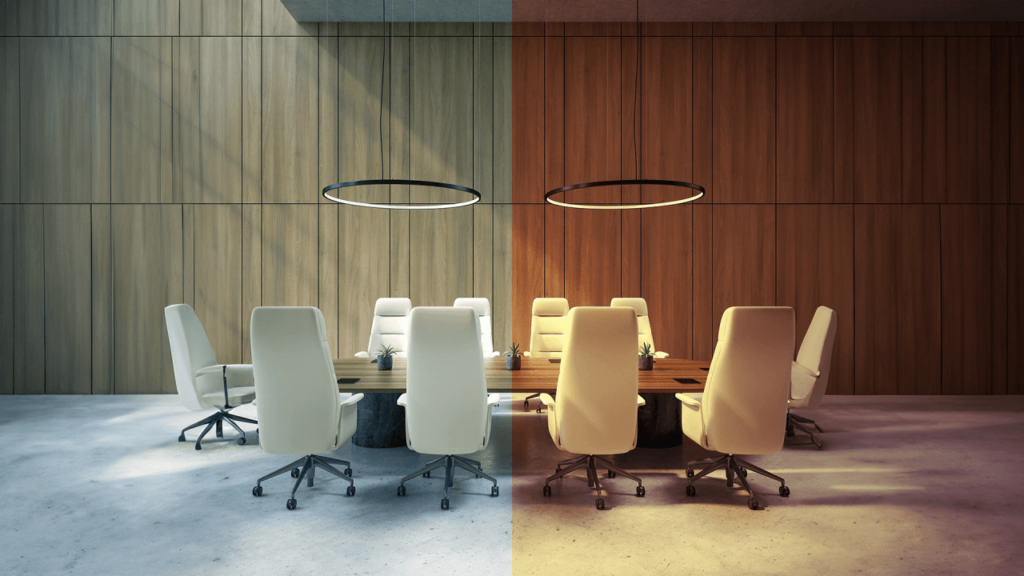
B. Advantages: Promotes Alertness and Visibility for Tasks
واحدة من أهم مزايا الإضاءة 6000k هي قدرتها على تعزيز اليقظة وتحسين الرؤية ، مما يجعلها خيارًا للبيئات الموجهة نحو المهمة. الضوء المشرق والبارد له تأثير محفز على العقل والجسم ، مما يجعل الأفراد مستيقظين ، مركزين ، وجاهزين للعمل التفصيلي. هذا مفيد بشكل خاص في المساحات مثل المرائب أو ورش العمل أو المكاتب ، حيث يكون التركيز والاهتمام بالتفاصيل أمرًا بالغ الأهمية.
على سبيل المثال ، في ورش العمل أو المرائب التي تكون فيها الدقة ضرورية - سواء كانت لإصلاح السيارات أو باستخدام الآلات أو العمل باستخدام أدوات - يضمن الإضاءة 6000k أن كل التفاصيل مرئية. يقلل المستوى العالي من السطوع من إجهاد العين ويعزز القدرة على التمييز بين الألوان والقوام ، وهو أمر ضروري للمهام التي تتطلب دقة. بالإضافة إلى ذلك ، يمكن أن تساعد الإضاءة 6000k في تقليل التعب خلال ساعات العمل الطويلة عن طريق الحفاظ على تنبيه الأفراد والتركيز.
في المساحات التي تفتقر إلى أشعة الشمس الطبيعية ، مثل الطوابق السفلية أو البيئات الصناعية المغلقة ، يمكن للإضاءة 6000k محاكاة ضوء النهار ، مما يوفر فوائد الضوء الطبيعي من حيث المزاج والإنتاجية والرفاهية. هذا مفيد بشكل خاص في المناطق التي يقضي فيها العمال أو الركاب فترات طويلة ، لأنه يساعد في الحفاظ على إيقاع الساعة البيولوجية الطبيعية ويدعم مستويات عالية من الإنتاجية طوال اليوم.
ج. العيوب: قد تخلق جوًا غير مرغوب فيه في بعض الغرف
بينما تتفوق الإضاءة 6000k في الإعدادات الموجهة نحو المهمة ، يمكن أن تخلق جوًا قاسيًا أو غير مرغوب فيه في الغرف المصممة للاسترخاء أو التفاعل الاجتماعي. يمكن أن يشعر الضوء البارد والمشرق بأنه صارخ وغير شخصي ، مما يجعله أقل ملاءمة للمناطق مثل غرف المعيشة أو غرف النوم أو مساحات الطعام ، حيث يكون الدفء والراحة ضروريين. في هذه البيئات ، يمكن أن يشعر السطوع المكثف للإضاءة 6000k السريرية أو الصناعية للغاية ، مما يعطل الأجواء المطلوبة.
على سبيل المثال ، في غرفة النوم ، يمكن أن يمنع الضوء المشرق المزرق من لمبة 6000 كيلو بايت الاسترخاء ويجعل من الصعب الاسترخاء قبل النوم. وبالمثل ، في غرفة المعيشة أو منطقة تناول الطعام ، قد يصطدم الضوء البارد بالشعور المريح والحميم الذي يتم البحث عنه عادة في هذه المساحات. يمكن أن تجعل البيئة تشعر بأنها معقمة وغير معقمة ، وتنتقص من الراحة الكلية وأجواء الغرفة. هذا هو السبب في أن درجات حرارة الألوان المنخفضة ، مثل 2700k-3000k ، يوصى غالبًا بالمساحات السكنية حيث يكون الدفء والاسترخاء مفتاحًا.
D. المناطق المناسبة: المرائب وورش العمل والطوابق السفلية والإعدادات الخارجية
تعد الإضاءة 6000k الأنسب للبيئات التي تكون فيها الوضوح والتركيز والوضوح العالي أولويات. المرائب are an ideal location for 6000K lights, as the bright illumination enhances visibility, making it easier to work on detailed tasks, such as vehicle repairs or equipment maintenance. The cool white light ensures that shadows are minimized and that every detail is visible, making the space more functional and safe for mechanical work or hobbyist activities.
Workshops also benefit from 6000K lighting, where detailed craftsmanship and the use of tools require high levels of brightness and precision. Whether working with wood, metal, or electronics, the daylight-like quality of 6000K lighting ensures that colors and materials are accurately represented, reducing errors and improving the overall quality of work.
In basements, where natural light is often limited or nonexistent, 6000K lighting can simulate daylight, making the space feel brighter and more inviting. This is particularly useful in basements used for storage, laundry, or even as a workspace, where adequate lighting is necessary for safety and functionality.
Finally, outdoor settings such as security lighting, parking lots, or landscape lighting benefit from the intense brightness of 6000K lighting. It provides maximum visibility and enhances safety, making it easier to see in low-light conditions or during nighttime. Outdoor security lights with 6000K bulbs can help deter potential intruders by illuminating dark areas around the home or commercial property, while landscape lighting can highlight features in a crisp, clean manner.
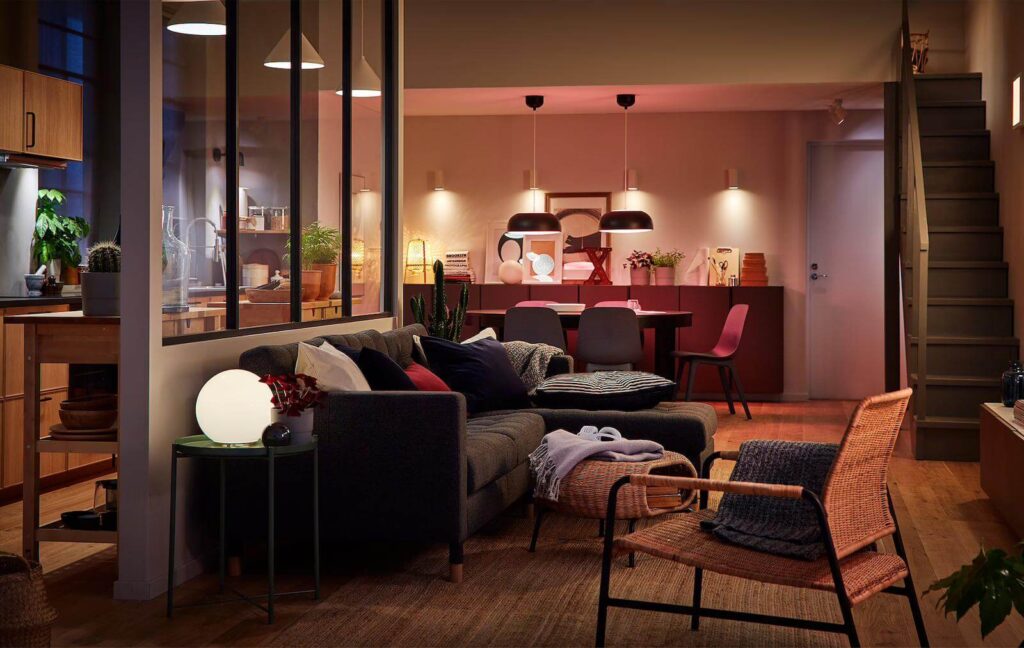
E. The Impact of 6000K Lighting on Productivity and Safety
تلعب الإضاءة 6000k دورًا مهمًا في تعزيز الإنتاجية والسلامة في الإعدادات المختلفة. إن النغمات المشرقة والرائعة تبقي الأفراد في حالة تأهب وتركيزها ، مما يجعلها أداة لا تقدر بثمن في مساحات العمل حيث تكون الكفاءة والاهتمام بالتفاصيل أمرًا بالغ الأهمية. على سبيل المثال ، في الإعدادات الصناعية ، تعمل الإضاءة 6000k على تحسين الرؤية ، وتقلل من الأخطاء ، وتساعد العمال على البقاء في حالة من اليقظة أثناء التحولات الطويلة ، مما يساهم في مستويات الإنتاجية الأعلى.
علاوة على ذلك ، من حيث أمان، الإضاءة 6000k حاسمة في البيئات التي يمكن أن تمنع فيها الرؤية الواضحة الحوادث أو الإصابات. في المرائب أو ورش العمل ، حيث يكون استخدام الأدوات الحادة أو الآلات الثقيلة أمرًا شائعًا ، يعد الإضاءة المناسبة ضرورية لتقليل خطر الحوادث. يضمن الوضوح الذي توفره مصباح 6000K أن كل حركة مرئية ، وأن المخاطر المحتملة أسهل في اكتشافها.
في الإعدادات الخارجية ، يعزز الضوء المشرق والهش الذي يبلغ 6000 ألف لمبات الأمن والسلامة من خلال تحسين الرؤية في المناطق التي قد تكون مظلمة أو سيئة الإضاءة. هذا يجعل من السهل على المشاة والسائقين وموظفي الأمن التنقل في المساحات بأمان مع ردع التهديدات الأمنية المحتملة.
في الختام ، على الرغم من أن الإضاءة التي تبلغ قيمتها 6000 كيلو قد لا تكون مثالية لكل غرفة في المنزل ، فإن قدرتها على تعزيز التركيز والرؤية والسلامة تجعلها لا غنى عنها في البيئات الموجه نحو المهمة أو الصناعية. سواء تم استخدامه في ورش العمل أو المرائب أو الطوابق السفلية أو المساحات الخارجية ، فإن الإضاءة 6000k توفر مزايا مهمة من حيث الإنتاجية والأمان ، مما يضمن أن كل التفاصيل مرئية وأن يتم تنفيذ كل مهمة بدقة.
اختيار الإضاءة المناسبة لمنزلك
تلعب الإضاءة دورًا مهمًا في تشكيل أجواء ووظائف وكفاءة الطاقة في منزلك. من خلال اختيار درجة حرارة الإضاءة المناسبة ، يمكنك إنشاء جو يناسب احتياجات كل غرفة محددة. إليك نظرة متعمقة على العوامل التي تؤثر على خيارات الإضاءة وبعض الاستراتيجيات لتجربة درجات حرارة ألوان مختلفة.
أ. العوامل التي تؤثر على اختيار درجة حرارة الإضاءة
1. الغرفة الغرض العامل الأساسي في اختيار درجة حرارة الإضاءة اليمنى هو الغرض من الغرفة. تخدم كل مساحة في منزلك وظيفة مختلفة ، ويجب أن تكمل الإضاءة هذه الوظائف:
- غرف المعيشة وغرف النوم غالبًا ما يستفيد من الإضاءة الأكثر دفئًا (حوالي 3000 ألف) ، مما يخلق جوًا مريحًا ومريحًا يفضي إلى الاسترخاء بعد يوم طويل.
- المطابخ والمكاتب المنزلية تتطلب إضاءة أكثر إشراقًا وأكثر برودة (4000 ألف) للوضوح والتركيز ، مما يسهل العمل أو إعداد وجبات بدقة.
- الحمامات غالبًا ما تحتاج إلى مزيج من الإضاءة. على سبيل المثال ، تساعد الإضاءة الباردة بالقرب من المرايا في الاستمالة ، في حين أن الإضاءة الأكثر ليونة في مكان آخر تحافظ على أجواء مريحة.
- المرائب والطوابق السفلية قد تتطلب إضاءة ألمع وأروع ، مثل 6000k ، لضمان الرؤية خلال المهام التفصيلية مثل إصلاحات السيارات أو الحرف اليدوية.
إن مطابقة درجة حرارة الإضاءة مع الغرض المحدد للغرفة يضمن الراحة والكفاءة في المهام اليومية.
2. الأجواء المطلوبة تؤثر درجة حرارة الإضاءة بشكل كبير على أجواء الغرفة. تخلق درجة حرارة اللون الدافئة (3000k أو أقل) مزاجًا جذابًا وحميميًا ، ومثاليًا للمساحات مثل غرف المعيشة أو غرف النوم أو مناطق تناول الطعام حيث يتم إعطاء الأولوية للراحة. على العكس من ذلك ، توفر درجات حرارة الألوان الباردة (4000 ألف وأعلى) جوًا أكثر نظافة وأكثر حيوية تعمل بشكل جيد في المناطق التي تكون فيها الإنتاجية مفتاحًا ، مثل المكاتب المنزلية أو المطابخ. يؤثر اختيار لون الإضاءة بشكل مباشر على شعور الغرفة - والاسترخاء أو المشرق والتنشيط.
3. كفاءة الطاقة كفاءة الطاقة هي اعتبار أساسي آخر عند اختيار الإضاءة. تعد مصابيح LED خيارًا أفضل لتوفير الطاقة لأنها تستخدم قوة أقل بكثير من المصابيح المتوهجة التقليدية. عند اختيار درجات حرارة الإضاءة ، ضع في اعتبارك أن خيارات الإضاءة الباردة تميل إلى أن تكون أكثر كفاءة في الطاقة أكثر من تلك الأكثر دفئًا بسبب تكوينها. ومع ذلك ، فإن الفرق هو الحد الأدنى ، وغالبًا ما يفوق التفضيل الشخصي ميزة الطاقة الطفيفة هذه. توفر مصابيح LED ، بشكل عام ، توازنًا بين الحفاظ على الطاقة وتوفير التكاليف على المدى الطويل ، لأنها تتمتع بعمر أطول من الأنواع الأخرى من المصابيح.
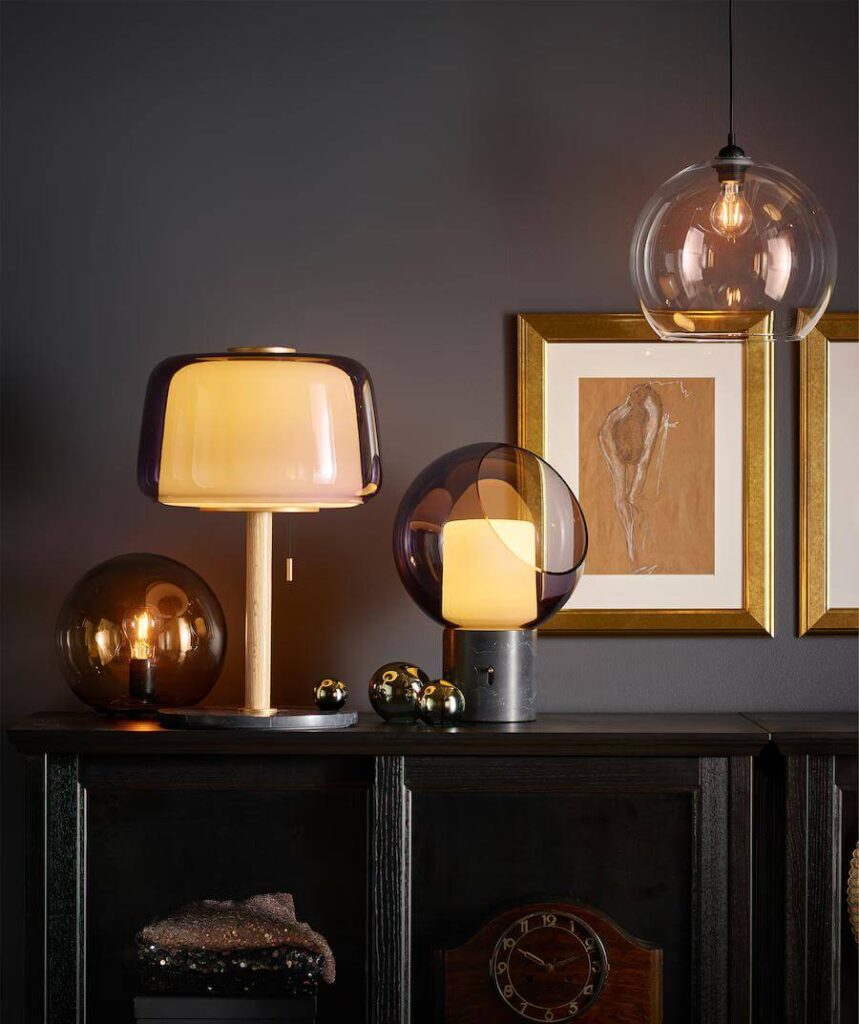
ب. دور التفضيل الشخصي في اختيار الإضاءة
في حين أن الوظيفة والأجواء أمران حاسمان ، فإن التفضيلات الشخصية تلعب دورًا كبيرًا في خيارات الإضاءة. كل شخص لديه حساسيات مختلفة للضوء. على سبيل المثال ، قد يجد بعض الأشخاص إضاءة أكثر برودة (من 4000 كيلو إلى 6000 ألف) قاسية للغاية بالنسبة للمساحات السكنية ، مفضلين الدفء الناعم للإضاءة البالغة 3000 ألف ، حتى في غرف ثقيلة المهام مثل المطابخ أو المكاتب. وبالمثل ، قد يختار أولئك الذين يفضلون الحد الأدنى والجمالية الحديثة مظهرًا أنظف للإضاءة الباردة في مساحاتهم المعيشية ، على الرغم من الاقتراح التقليدي للنغمات الدافئة. يعد الذوق الشخصي والراحة والأسلوب العام لمنزلك مفتاح اللمسات الأخيرة على قرارات الإضاءة الخاصة بك.
جيم استراتيجيات لتجربة درجات حرارة ألوان مختلفة
عند تحديد أفضل درجة حرارة الإضاءة لمنزلك ، من الضروري تجربة خيارات مختلفة. فيما يلي بعض الاستراتيجيات للعثور على ما هو أفضل:
- استخدم مصابيح LED قابلة: تتيح لك الأضواء القابلة للتجزئة تغيير شدة الإضاءة لتناسب مزاج ومهام مختلفة. كما أنها توفر وسيلة للتحول بين النغمات الباردة والدفء إذا قمت بتحديد مصابيح LED قابلة للضبط ، مما يوفر مرونة أكبر في تركيبات واحدة.
- جرب مصابيح LED القابلة للتعديل أو القابلة للضبط: تتيح لك بعض تركيبات LED الحديثة ضبط درجة حرارة اللون نفسها ، والتبديل بين نغمات أكثر دفئًا أو محايدة أو أكثر برودة. هذا مثالي للمساحات التي تخدم أغراض متعددة ، مثل المكتب المنزلي الذي يعمل أيضًا كمنطقة استرخاء في المساء.
- اختبار الإضاءة في غرف مختلفة: نظرًا لأن الإضاءة تؤثر على الحالة المزاجية والوظائف ، فحاول وضع المصابيح بدرجات حرارة ألوان مختلفة في غرف مختلفة. على سبيل المثال ، ابدأ بالإضاءة الدافئة في غرفة المعيشة والإضاءة الباردة في الحمام أو المطبخ. بمرور الوقت ، لاحظ كيف تؤثر درجات الحرارة هذه على راحتك وإنتاجيتك في كل مساحة.
- النظر في وضع وضع الإضاءة الخاصة بك: تتيح لك الإضاءة ذات الطبقات ، والتي تتضمن إضاءة المحيطة والمهمة واللكنة ، مزج درجات حرارة ألوان مختلفة لإنشاء مساحة أكثر ديناميكية وتنوعا. على سبيل المثال ، قد تستخدم الإضاءة الدافئة للضوء المحيط ولكن إضاءة المهام الأكثر برودة في مناطق العمل ، مما يمنحك أفضل ما في العالمين.
تأثير الإضاءة على الحالة المزاجية والصحة
الإضاءة ليست مجرد مسألة جمالية ووظائف ؛ يلعب دورًا مهمًا في التأثير على مزاجنا ومستويات الطاقة والصحة العامة. يمكن للإضاءة الصحيحة تحسين التركيز والإنتاجية ، في حين أن النوع الخاطئ يمكن أن يعطل النوم ورفع الإجهاد. تستكشف هذه المقالة كيف تؤثر درجات حرارة الإضاءة المختلفة على الجسم ، مع التركيز على تأثيرها على مستويات الميلاتونين والسيروتونين ، وأهمية الحفاظ على دورة صحية للنوم ، وكيفية تصميم مخطط إضاءة يدعم الرفاهية المادية.
أ. كيف تؤثر درجات حرارة الإضاءة المختلفة على مستويات الميلاتونين والسيروتونين
Lighting temperature is more than a visual choice; it directly impacts the body’s biochemical processes. The two key hormones influenced by light exposure are melatonin and serotonin, which regulate sleep and mood.
- Melatonin is the hormone responsible for regulating the sleep-wake cycle. It is primarily produced in darkness, encouraging a state of relaxation and promoting sleep. Exposure to warmer, lower-temperature lighting (such as 3000K and below) can stimulate melatonin production, helping individuals feel drowsy and ready for rest. This is why warm lighting is often recommended in bedrooms and living spaces where relaxation is a priority.
- Serotonin, on the other hand, is a hormone that promotes feelings of well-being, happiness, and energy. Exposure to cooler, higher-temperature lighting (4000K and above) simulates daylight, which encourages serotonin production. This can help boost alertness, concentration, and overall mood, making cooler lighting ideal for environments where productivity is essential, such as offices, kitchens, and workspaces.
The spectrum of lighting temperatures can thus either enhance relaxation or promote alertness. Warmer light (3000K) encourages melatonin production, aiding in relaxation and sleep, while cooler light (4000K to 6000K) boosts serotonin, making you more alert and energized. The careful use of these lighting temperatures can significantly impact how you feel and perform throughout the day.
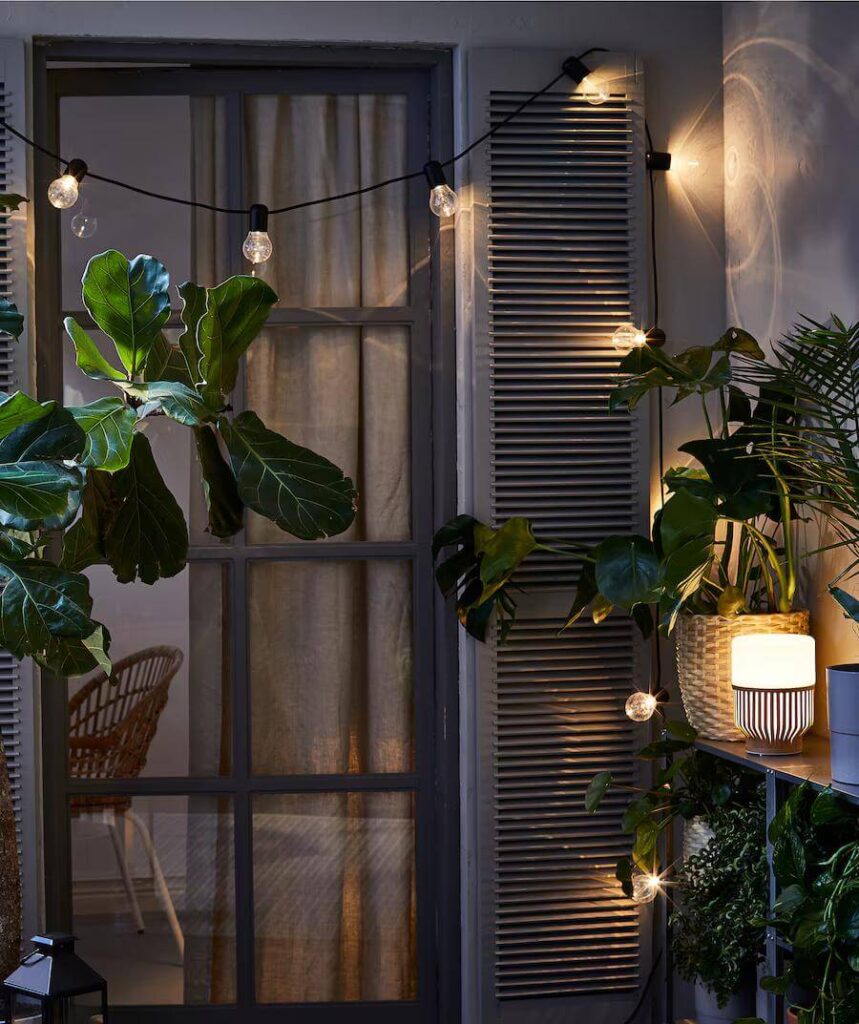
B. The Importance of a Healthy Sleep-Wake Cycle and Its Relation to Lighting
The sleep-wake cycle, or circadian rhythm, is one of the most critical bodily functions influenced by light. This internal clock helps regulate when we feel awake and when we become tired, in sync with natural daylight. In today’s modern world, artificial lighting has a significant influence on this cycle, and improper lighting can lead to disruptions.
عندما نتعرض للضوء اللامع والبارد (6000K وما فوق) في وقت متأخر من المساء ، يمكن أن يؤخر إنتاج الميلاتونين ، مما يجعل من الصعب النوم والتأثير سلبًا على جودة الراحة. وذلك لأن الدماغ يفسر الإضاءة الباردة كضوء نهار ، والذي يشير إلى الجسم للبقاء في حالة تأهب. بمرور الوقت ، يمكن أن يؤدي هذا الاضطراب إلى الأرق والتعب وحتى اضطرابات المزاج مثل الاكتئاب والقلق.
Conversely, inadequate lighting during the day—especially if you’re working indoors in dim lighting—can fail to stimulate serotonin production. Without adequate exposure to bright, cool light, your body may struggle to stay alert and energized, further disrupting the sleep-wake cycle. In extreme cases, insufficient lighting exposure can lead to Seasonal Affective Disorder (SAD), a form of depression related to low light exposure during certain seasons.
Creating a lighting environment that aligns with your circadian rhythm is crucial for maintaining a healthy sleep-wake cycle. The key is to mimic the natural light patterns we experience outdoors: cooler, brighter lighting during the day and softer, warmer lighting as the evening progresses.
ج. نصائح لإنشاء مخطط إضاءة يدعم الرفاه المادي
بالنظر إلى التأثير القوي للإضاءة على الحالة المزاجية والصحة ، من الضروري إنشاء مخطط إضاءة يدعم كل من رفاهتك العقلية والبدنية. فيما يلي بعض النصائح لتحسين الإضاءة للصحة:
1. استخدم الضوء الطبيعي كلما كان ذلك ممكنًا
أشعة الشمس الطبيعية هي الطريقة الأكثر فعالية لتنظيم إيقاعك البيولوجي وتعزيز الرفاهية بشكل عام. حاول أن تدع أكبر قدر ممكن من ضوء النهار ، خاصة في الصباح. فتح الستائر والستائر لإغراق مساحتك بالضوء الطبيعي ، وفكر في العمل بالقرب من النوافذ لزيادة التعرض. إذا كان الضوء الطبيعي محدودًا ، ففكر في الاستثمار في مصابيح العلاج بالضوء المصممة لتقليد ضوء النهار.
2. دمج الإضاءة ذات الطبقات
A well-designed lighting scheme uses layers: ambient, task, and accent lighting. This approach allows you to use different lighting temperatures throughout the day to suit your needs:
- Ambient lighting provides overall illumination and can be set to warmer tones in the evening to promote relaxation.
- Task lighting in workspaces should be cooler (4000K to 6000K), ensuring that you can focus without strain. Adjustable or tunable lighting that shifts between warm and cool temperatures throughout the day is ideal for offices or study areas.
- Accent lighting can be used to enhance the ambiance of a room, with dimmer controls allowing you to switch between different lighting temperatures as needed.
3. Use Dimmable or Tunable LEDs
Invest in dimmable or tunable LED lights that allow you to adjust the brightness and color temperature according to the time of day. Dimmable LEDs are particularly useful in the evening, as they help create a calming environment by reducing brightness and transitioning to warmer tones, which encourage melatonin production. Tunable LEDs are even more versatile, allowing you to shift from energizing daylight-like lighting in the morning to softer, relaxing hues in the evening.
4. Avoid Exposure to Cool Lighting Before Bed
مع اقتراب وقت النوم ، من الضروري تقليل التعرض للإضاءة الأكثر برودة والأزرق. يتضمن ذلك شاشات من الهواتف الذكية وأجهزة الكمبيوتر وأجهزة التلفزيون ، بالإضافة إلى إضاءة علوية مشرقة. بدلاً من ذلك ، اختر الإضاءة الدافئة أو الإضاءة الدافئة (3000K أو أقل) في مساحات المعيشة وغرفة النوم لتشجيع إنتاج الميلاتونين وإعداد جسمك للنوم.
5. النظر في حلول الإضاءة اليومية
تم تصميم بعض أنظمة الإضاءة المتقدمة لمحاكاة التقدم الطبيعي لضوء النهار. تقوم حلول الإضاءة اليومية هذه تلقائيًا بضبط درجة حرارة اللون وسطوع الأضواء طوال اليوم ، مما يدعم إيقاعك الطبيعي. على الرغم من أن هذه الأنظمة يمكن أن تكون أكثر تكلفة ، إلا أنها مثالية لأولئك الذين يبحثون عن نظام إضاءة يركز على الصحة.
تأثير الإضاءة على الحالة المزاجية والصحة عميق. من خلال فهم كيفية تأثير درجات حرارة الإضاءة المختلفة على الهرمونات مثل الميلاتونين والسيروتونين ، وتصميم مخطط إضاءة يتوافق مع إيقاعك الساعة البيولوجية ، يمكنك تعزيز رفاهيتك المادية. سواء من خلال الإضاءة الطبيعية أو الإضاءة ذات الطبقات أو حلول الإضاءة الذكية ، يمكن أن تساعد الخيارات الصحيحة في تحسين النوم والتركيز والصحة العامة.
التطبيقات والنصائح العملية
Lighting is one of the most versatile tools in home design, with the power to alter mood, enhance functionality, and elevate aesthetics. Beyond simply illuminating a space, thoughtful lighting design incorporates a variety of techniques to create environments that serve practical needs while promoting comfort and visual interest. This section will explore practical applications of lighting across different rooms, techniques for layering lighting, and how dimming and smart technologies enhance flexibility and energy efficiency.
A. Case Studies of Effective Lighting in Different Types of Rooms
1. Living Room: Creating a Cozy and Functional Space The living room is a multifunctional space where people relax, entertain, and sometimes work. As such, the lighting needs to cater to a variety of activities, blending both style and practicality. In one case, a designer used a combination of warm, ambient lighting from overhead chandeliers, combined with task lighting from table lamps, to create a cozy yet functional environment. The room also featured accent lighting in the form of LED strip lights behind shelving units, illuminating art and decor.
في هذا الإعداد ، حقق المصمم توازنًا بين الجو والوظائف. وفرت الإضاءة الدافئة التي تبلغ قيمتها 3000 ألف راحة ، في حين أن النهج ذو الطبقات يضمن وجود إضاءة كافية لقراءة أو مسلية للضيوف. سمحت خيارات التعتيم لأصحاب المنازل بالتحول بين الإضاءة المشرقة الوظيفية أثناء التجمعات وأجواء أكثر ليونة وأكثر حميمية خلال ليالي الأفلام.
2. المطبخ: موازنة إضاءة المهام والجمال يتطلب المطبخ إضاءة واضحة ومشرقة لإعداد الطعام ، ولكنه يستفيد أيضًا من إضاءة أكثر ليونة لتناول الطعام أو التواصل الاجتماعي. تبرز إحدى دراسة الحالة مطبخًا حديثًا حيث قام المصمم بدمج مزيج من الإضاءة المريحة العلوية في درجة حرارة 4000 كيلو باردة ، مثالية لأعمال المهمة ، وأضواء قلادة فوق جزيرة المطبخ لأغراض محيطة وزينة. تم استخدام إضاءة تحت cabinet أيضًا لإلقاء الضوء على أسطح كونترتوب ، مما يوفر إضاءة مهمة دون الحاجة إلى مصابيح علوية قاسية.
سمح هذا التصميم لمستويات الإضاءة المختلفة بناءً على وقت اليوم والنشاط في متناول اليد. في الصباح ، جعلت إضاءة المهام المشرقة المطبخ يشعر بالحيوية والوظيفية ، بينما في المساء ، يعطل مصابيح القلادة ومصابيح LED تحت cabinet أجواء أكثر استرخاء ومرحبة لتناول العشاء أو المحادثة غير الرسمية.
3. غرفة النوم: تعزيز الاسترخاء وجودة النوم غرف النوم هي مساحات للراحة ، ويجب أن تعكس الإضاءة ذلك. في مخطط إضاءة فعال واحد ، سمحت مجموعة من الضوء المحيط الدافئ (2700 كيلو) من مصابيح طاولة السرير ، المكملة بأضواء قابلة للتعديل ، لأصحاب المنازل بالتحكم في الإضاءة بناءً على احتياجاتهم. قدمت الأضواء المريحة ضوءًا أكثر إشراقًا للأنشطة مثل القراءة ، بينما عززت مصابيح الطاولة الدافئة الاسترخاء وإنتاج الميلاتونين قبل وقت النوم.
أثبت هذا إعداد الإضاءة المرن فعاليته في الترويج لبيئة مريحة ، حيث سمحت الميزات القابلة للتطبيق إلى التحولات السهلة من الاسترخاء المسائي إلى إجراءات الصباح. عزز استخدام الضوء الدافئ في جميع أنحاء الغرفة شعور بالهدوء ، مما يضمن أن المساحة مفضية للنوم.
ب. تقنيات لطبقات الإضاءة لخلق العمق والاهتمام
الإضاءة الطبقات هي تقنية تستخدم لتعزيز عمق الغرفة والاهتمام البصري من خلال الجمع بين أنواع مختلفة من الإضاءة: الإضاءة المحيطة والمهمة واللكنة.
1. الإضاءة المحيطة هذا هو المصدر الأساسي للضوء في غرفة ، وعادة ما توفرها التركيبات العلوية مثل الثريات أو الأضواء المريحة أو التركيبات المثبتة على السقف. تضمن الإضاءة المحيطة أن تكون الغرفة مضاءة بشكل متساوٍ وآمنة للانتقال إليها. على الرغم من أن الإضاءة المحيطة الوظيفية يمكن تخفيفها من خلال استخدام المفاتيح القابلة للتجديد ، مما يتيح إعدادات أكثر حميمية حسب الحاجة.
2. إضاءة المهام Task lighting is focused lighting meant to illuminate specific areas where detailed activities are performed, such as reading, cooking, or working. Common task lights include desk lamps, pendant lights, or under-cabinet lights in the kitchen. For example, in home offices or kitchens, a cool 4000K or higher temperature lighting is used to promote focus and visibility, while warmer lights are preferred for relaxation areas like living rooms or bedrooms.
3. Accent Lighting Accent lighting serves a decorative purpose, drawing attention to specific features in a room, such as art, architectural details, or bookshelves. This lighting is usually more directional and less intense than task lighting. LED strip lights, sconces, and track lighting are popular choices for accent lighting. By adding these focal points, accent lighting creates a sense of depth and visual interest, transforming the space from flat and functional to dynamic and engaging.
مثال جيد على الطبقات الإضاءة هو غرفة معيشة تتضمن الأنواع الثلاثة. توفر الأضواء المحيطة العلوية الإضاءة العامة أو مصابيح الطاولة أو مصابيح الأرضية إضاءة مركزة للمهمة ، وتبرز الإضاءة لللكنة الفن أو النباتات. معًا ، يخلق هذا النهج الطبقات مساحة ديناميكية ومتعددة الاستخدامات حيث يمكن لأصحاب المنازل ضبط الإضاءة لتناسب أي مزاج أو مناسبة.
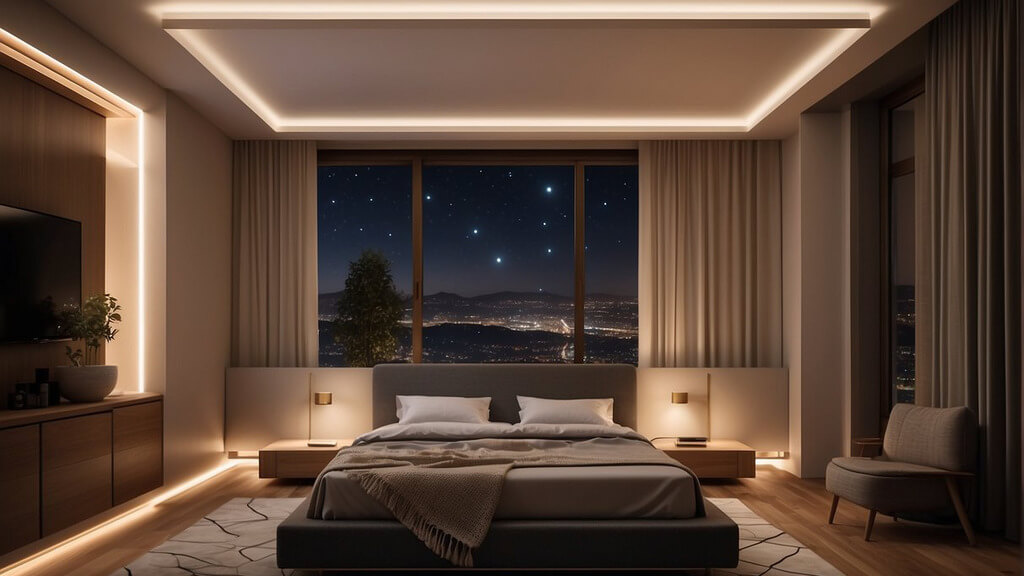
ج. فوائد تقنيات الإضاءة الذكية وتقنيات الإضاءة الذكية
1. المرونة في التحكم في الإضاءة Dimming technology offers immense flexibility, allowing you to adjust the brightness of your lights based on the time of day or the activity. Whether you’re winding down after dinner or hosting a vibrant gathering, the ability to dim lights helps you set the right tone. For example, dimming down 4000K task lighting in the kitchen after cooking turns the space into a cozy social zone without needing to switch fixtures. Similarly, in the bedroom, dimming lights down to a warmer, softer glow can signal your body to start relaxing and preparing for sleep.
يعزز أيضا كفاءة الطاقة. من خلال خفض شدة الأضواء ، فإنك تستهلك كهرباء أقل ، والتي يمكن أن تمدد عمر المصابيح الكهربائية. هذا مفيد بشكل خاص لإضاءة LED ، التي تستهلك بالفعل طاقة أقل من المصابيح المتوهجة التقليدية.
2. تقنيات الإضاءة الذكية Smart lighting takes flexibility a step further, offering advanced control through automation, mobile apps, and voice commands. With smart bulbs, you can schedule lighting changes based on your daily routine, such as gradually brightening lights in the morning to simulate sunrise or dimming them in the evening to promote relaxation. Smart systems allow you to adjust color temperatures as well, switching between cooler tones for morning energy and warmer hues for evening comfort.
For instance, smart lighting in a home office can be set to 5000K during working hours to improve focus, and later shift to 3000K in the living room for relaxation. Many smart lighting systems are also compatible with home automation devices like Alexa or Google Home, enabling hands-free control. The convenience and customization of smart lighting help create spaces tailored to both your practical needs and your well-being.
3. كفاءة الطاقة Both dimming and smart lighting technologies contribute to energy savings. By using only the amount of light you need at any given moment, you reduce energy waste, ultimately lowering your utility bills. Furthermore, smart lighting systems often come with motion sensors or occupancy detectors, ensuring that lights turn off automatically when a room is not in use. This adds an extra layer of efficiency, making your home eco-friendlier while extending the lifespan of your bulbs.
The thoughtful application of lighting can transform a room, making it more functional, inviting, and energy-efficient. By exploring case studies of effective lighting design, implementing layered lighting for depth, and integrating dimming and smart technologies, homeowners can create versatile spaces that cater to both mood and practicality. Whether it’s achieving the perfect ambiance for relaxation or boosting productivity, lighting has the power to significantly impact both the aesthetics and functionality of your home.
خاتمة
Choosing the right lighting temperature is essential for creating a comfortable and functional living environment. The appropriate lighting not only enhances the aesthetic appeal of a room but also impacts mood, productivity, and even health. As explored, different lighting temperatures—from the warm glow of 3000K to the cooler brightness of 6000K—offer distinct benefits depending on how they are applied. Warm lighting is ideal for relaxation and unwinding, while cooler lighting boosts alertness and focus, making it perfect for task-oriented spaces. Ultimately, selecting the right temperature is crucial for ensuring that your home feels both inviting and practical.
A key factor in selecting lighting is to consider the purpose of the room and the mood you want to evoke. A living room, designed for comfort and social interaction, will benefit from warmer, softer lighting, creating a cozy atmosphere. Conversely, a home office or kitchen, where clarity and precision are required, needs cooler, brighter lighting to keep energy levels high. By aligning the lighting temperature with the room’s intended function, you can ensure that the space meets both practical and emotional needs.
Achieving the perfect lighting balance involves more than just choosing a single fixture or temperature. As highlighted, layering different types of lighting—ambient, task, and accent—creates a more dynamic, functional, and visually engaging space. Moreover, incorporating dimming and smart lighting technologies allows for flexibility, enabling you to adjust brightness and color temperature to suit various activities and moods throughout the day.
In conclusion, lighting is a powerful tool that, when thoughtfully chosen, can transform your home. By carefully considering each room’s purpose and desired ambiance, and utilizing the flexibility of modern lighting technologies, you can create spaces that are both beautiful and perfectly suited to your lifestyle.
شراء شراء مصابيح LED من Ledaplus
When it comes to selecting the right lighting for your home or business, LEDAPLUS Lighting Manufacturer provides a wide range of high-quality LED lighting solutions designed to meet various needs and preferences. Whether you’re looking for warm, ambient lighting to create a cozy atmosphere or bright, cool lighting for task-oriented spaces, LEDAPLUS has you covered. With a commitment to energy efficiency and sustainability, their LED lights are not only environmentally friendly but also cost-effective, offering long-term savings on energy bills.
LEDAPLUS offers a broad selection of lighting options, including downlights, track lights, spotlights, and panel lights. Each product is designed with versatility and durability in mind, allowing you to find the perfect lighting solution for any room in your home or office. Their range of color temperatures ensures that you can create the desired ambiance and functionality in every space.
At the heart of LEDAPLUS’s mission is customer satisfaction. They prioritize understanding the unique needs of their customers and offering personalized guidance to help you choose the best lighting options. If you have any inquiries or require assistance, their dedicated customer service team is ready to provide expert advice and support, ensuring a seamless and satisfying experience.

